







+ The shifting tastes of the rebounding property market p24
Why make bridging difficult. Talk to Somo today.



Our specialist Unregulated Bridging Team is comfortable handling larger scale refurbishments and conversions where planning permission is required, or the property has a change of use.
FLEXIBLE PRICING | LIGHT & HEAVY REFURBISHMENT PRODUCTS | IN-HOUSE SURVEYOR
Editor-in-chief
Beth Fisher
Deputy editor
Andreea Dulgheru
Creative direction
Beth Fisher
Andreea Dulgheru
Sub editor
Christy Lawrance
Andrea Johnson
Contributors
Nick Baker, Colin Sanders, Randeesh Sandhu, Karen Dunstan, Mike Cook, Scott Howitt, Andrew Montlake, William Lloyd-Hayward, Nicola Firth, Martin Reynolds, Rob Stanton, Jason Berry, Sarah Milne
Photography
Alexander Chai
Illustration
Valf
Sales and marketing
Beth Fisher
beth@medianett.co.uk
Special thanks Katrina Hindley, TAB
Aaron Noone, Master Finance Specialist Brokers
Michael Davey, OSB Group
Paul Moran, Together Tom Harding, Aldermore Bank
Printing
The Magazine Printing Company
Design and image editing
Jana Rade, impact studios
Bridging & Commercial Magazine is published by Medianett Publishing Ltd
Managing director
Beth Fisher
beth@medianett.co.uk 0203 818 0160 Follow us: Twitter @BandCNews | Instagram @medianettpublishing
To read about our commitment to the environment and sustainable print publishing, please visit https://bridgingandcommercial.co.uk/page_magazine.
As I write this, I have California Dreamin’ by the Mamas & the Papas playing on loop in the background, and my iced coffee has been swapped with a mug of spiced chai—Autumn has officially arrived. In contrast to its backdrop of browning leaves and greying skies, this season marks a period of significant momentum in the specialist finance sector, where businesses are fervently pursuing their year-end ambitions. But real action, the kind that matters, isn’t always about hitting short-term goals. It’s about creating something with staying power, something that shapes a more sustainable future. This issue of B&C Magazine dives headfirst into how firms in our market are working to make this a reality, and just how far they’ve come.
Our cover story, ‘Beyond numbers: The real story of measuring ESG’ [p40], peels back the layers on how specialist finance firms are embedding ESG into their core practices and the hurdles they face in trying to quantify their impact. From championing charitable initiatives and supporting employee wellbeing to offsetting emissions and elevating board diversity, it’s clear there’s no one-size-fits-all strategy to measure success. We explore how the sector is navigating this journey year-on-year and what it means for the future of our market.
We continue our ‘Moulding the next generation’ series with part two, where Marc Goldberg, commercial CEO at Together, shares the spotlight with two of his standout mentees: chief commercial officer Ryan Etchells, and corporate relationship director Ben Storey. Their candid conversation is a masterclass in mentorship, excellence, and driving a culture of responsibility in today’s finance world [p81].
We also have exclusive insights from Mike Cook, chief mortgage officer at MFS, who offers his expert view on the shifting preferences of a resurgent property market and what these trends mean for ESG considerations [p24]. Meanwhile, Paragon Bank’s managing director, Neal Moy, reveals how the bank’s development finance division has reached a remarkable £3bn in lending and shares the secret ingredient to their recipe for success—spoiler alert: it involves ESG [p60].
In light of Allica Bank’s recent acquisition of Tuscan Capital, we bring you an exclusive sit-down with Nick Baker, Allica Bank’s chief commercial officer, and Colin Sanders, Tuscan’s founder and CEO, as they unpack how this dynamic duo plans to become the breakout bridging lender in an increasingly competitive space [p14].
To round things off, we went on-site to Crystal Specialist Finance’s headquarters, getting a firsthand look at what it takes to keep the wheels turning at this dynamic specialist distributor [p73]. And in a heartfelt feature, we spotlight the Mortgage Industry Mental Health Charter (MIMHC). Its seven co-founders open up about the evolution, growth, and triumphs of the charter to date and share their bold plans to guide finance companies in supporting their teams through the toughest times [p33].
I hope this issue reminds you that in our quest for a more sustainable and conscious industry, the impact we create transcends mere facts and figures. As one of our cover story experts so eloquently put it, “The story behind what you’re doing is just as important as the hard metrics”.
Beth Fisher
“The threat of looming costs, courtesy of the Autumn Budget, may encourage some to move to more humble abodes”
p24
14 20 24 33
40
60
73
81
98
100

ESG comes in many shapes and forms—mental health and wellbeing provisions, charity activities, environmental policies, you name it. To celebrate the steps this industry is taking to embrace ESG, we take a look at some of the most recent initiatives and policies firms have implemented as part of their strategy
'Ladies Who Cannes' initiative launched to support women taking aim at MIPIM
A new initiative, Ladies Who Cannes, has been launched to help women who have previously shied away from attending MIPIM. Ladies Who Cannes was created by Anastasia Ttofis, CEO and co-founder of iLA; Kim McGinley, MD at VIBE Finance; and Rosalia Lazzara-Tilley, CEO at Manuka Media.
The initiative’s mission is to change the “blue gilets and beige chinos” face of MIPIM which they said has often been portrayed as a male dominated environment—the group also aims “to provide a safe and inclusive community for networking, learning and growth”.
Commenting on the initiative, Anastasia said: “We created ‘Ladies Who Cannes’ because we saw a real need for a community where women could come together, support one another, and make the most out of their MIPIM experience. Our goal is to build a network that not only helps women prepare for MIPIM 2025 but also provides them with the confidence and connections they need to thrive.”
Kim added: “We want to ensure that every woman who attends our events feels included, supported, and ready to take on the challenges and opportunities that MIPIM presents.”
This October will see the launch of the industry’s first Women in Finance Retreat. The event has been created by Kim McGinley, MD at VIBE Finance, and Rosalia Lazzara-Tilley CEO at Manuka Media, and will take place between 10-12th of October 2024.
The retreat aims to offer a space where business owners can hear educational expert talks, attend motivational and career development workshops, as well as engage in networking opportunities with industry leaders. Also included are scenic walks, yoga sessions, and gourmet dinners, in what is designed to mix professional development with personal wellbeing.
"We're thrilled to launch this retreat to support and inspire women who are shaping the future of finance,” said Kim. “Our goal is to create an environment that not only fosters learning and collaboration, but also celebrates the achievements of women in our field."
Galliford Try is piloting a mentoring scheme aimed at encouraging women to enter the construction industry.
The housebuilder has teamed up with five schools in the east midlands to pilot a three-year programme where students will be paired with female mentors to showcase the sector.
Commenting on the programme, Vikki Skene, group HR director at Galliford Try, said: “By introducing our Mentoring the Next Generation Programme, we aim to break down these barriers, demonstrating a hugely fulfilling, rewarding, and flexible career with a variety of roles available that girls and young women may not yet know are possibilities for them in an environment that enables them to be successful.”
The lunch was held at the fabulous Brasserie of Light in London in September, featuring a talk on imposter syndrome by business coach Kerry Jones. It was a space where vulnerability and authenticity thrived, allowing women to share their experiences and challenges openly.
“Connecting with other women who face similar feelings of self-doubt was both reassuring and empowering,” stated Juliet Baboolal, real estate partner at Gunnercooke. “Hearing their stories reminded me that I am not alone in my struggles and that many of us navigate the same internal battles. This event was a reminder of the importance of celebrating our achievements, no matter how small. It encouraged me to embrace my journey, challenge my self-doubt, and strive to be the best version of myself while lifting others along the way.”
Kerry added: “Imposter syndrome is simply a sign that you’re stepping into new territory. Embrace it as a catalyst for growth, and remember that the most successful people often feel like imposters at some point. Your journey is unique, and your voice matters—own it!”
OSB Group is providing its staff with domestic abuse awareness training alongside bolstering support offered to colleagues, coinciding with Mental Health Awareness Week.
Training is being provided by a refuge for women and children, The Haven, via the Purple Pledge, a scheme that aims to ensure that workplaces are open and safe spaces where employees can feel comfortable disclosing abuse, and whereby employers and colleagues are able to support them.
Neil Richardson, chief sustainability officer at OSB Group, said: “The strong partnerships we hold within our local communities is something we are immensely proud of here at OSB Group.
“To be able to share knowledge and training is really valuable to all involved—not only have we been able to give training to charity partners, but we are also going to receive training from charity partners too. This demonstrates the importance of partnerships going deeper than monetary funding, although that too is key to the support we provide.”
Pepper Money has hosted its first broker wellbeing event as part of its ‘Be More You’ campaign.
The event called ‘Retreat’, saw 40 invited guests attend and was held at Menier Penthouse in London on 10th July and featured a morning of mindfulness, wellbeing, and relaxation, with a range of sessions designed to help brokers take a step back from their busy routine.
Paul Adams, sales director at Pepper Money, said: “The event was designed to give our broker partners and industry colleagues an opportunity to step away from their busy daily routines, and attendees heard from inspirational speakers on some very important topics as well having as the opportunity to network with like-minded individuals in a very open and honest platform.”
Knight Frank has launched a social values consultancy team for the firm. The Knight Frank social value consultancy team will help clients “incorporate social value” into their investment decisions. According to the firm, this will lead to better leasing and investment performance, stronger community engagement, and enhanced occupier wellbeing and satisfaction.
Kalli Stuart, social value consultant at Knight Frank, said: "Social value is gaining momentum and is hugely important to our industry and to wider society. I see a significant opportunity to help our clients enhance the positive impact of their projects and properties.”
Jonathan Hale, head of ESG consulting (UK) at Knight Frank, added: “We will support our clients in maximising the positive impact of their properties on stakeholders and creating social value. Kalli’s expertise will be key to our continued success in delivering strategic social value consultancy.”
Clarion Housing Group has published a new Sustainable Housing Finance Framework, which meets investors’ growing needs around reporting and transparency.
It sets out clearly the eligible projects that investors monies will be used for, showing how each category of project aligns to the sustainability reporting standard (SRS) for social housing, UN sustainable development goals, and Clarion’s own sustainability strategy.
Andrew Hill, Clarion’s director of treasury and corporate finance, commented: “Clarion’s purpose is to make a difference, and we do that by delivering significant environmental and social value.”
Miles Lewis, Clarion’s director of sustainability, added: “I recognise the important role our investors have to play in order for us to deliver on our sustainability strategy. I am pleased to have had the opportunity to work closely with our treasury team in constructing a finance framework which will help us deliver for our residents, our people, and the planet.”
Following Allica’s acquisition of Tuscan Capital, Allica Bank’s chief commercial officer Nick Baker and Tuscan’s founder and CEO Colin Sanders discuss how their combined strengths will enable them to become a break-out bridging lender
WORDS BY NICK BAKER Chief commercial officer at Allica Bank
Well, we’ve done it— Allica is now in the bridging market!
And we’re delighted to be doing so by bringing in house the expertise of the team at Tuscan Capital.
That Allica should enter the bridging market was never in doubt. Indeed, I distinctly remember discussing the opportunity when I was interviewed to join Allica six years ago—although it feels like only yesterday.
Bridging is a natural progression for Allica. Many of our customers have a variety of property interests, while our introducer panel includes many who also broker bridging deals for their clients. This acquisition means we’ll be able to deepen these relationships and help our existing customers further, alongside supporting a new batch of businesses and brokers to secure finance.
We’ve been flattered over the years by the number of brokers who have encouraged us to enter bridging. We know from our regular surveys that many have been keen for us to bring our award-winning combination of relationships and technology to a market that desperately needs it. This has particularly been the case around fully commercial bridging, where the funding of transactions often means many non-bank lenders can really struggle.
Ultimately, though, the driving force behind this decision was the belief that we could really make a difference for brokers and businesses. The sector has lagged behind when it comes to innovation and service, and is crying out for a no-nonsense business bank that can deliver bridging finance at scale. With a £5bn-plus market, there is a big opportunity to make an impact and help businesses grow.
So there was never an “if” when it came to Allica entering bridging. Instead, the questions were more around “when” and “how”.
The main decision we had to make was whether to develop a new bridging proposition from scratch or acquire an existing lender. Having already built Allica’s own commercial mortgage, asset finance, growth finance, savings and current account products, it’s fair to say we know how to do things ourselves.
This time, however, the thinking was different. Building from scratch would be time-consuming and divert resources away from other parts of the business. In addition, the size of the talent pool for bridging sales, operations and risk would make building a team from scratch a real challenge. All the while, demand for an Allica bridging product was growing and, having recently been named the fastest-growing company in The Sunday Times 2024 and becoming profitable, we were keen to maintain momentum.
So, to accelerate our plans to establish Allica as a leading bridging lender, we opted to look for a potential acquisition. From day one, the key was that we found a lender that shared our values and focused on service, alongside our ambitions to raise expectations in the market, and could bring with it the expertise and network to make an instant impact. Thankfully, we’d found exactly the right business to help us do this.
Our first contact with Colin Sanders, Ed Parsons, and the Tuscan team was in April. We knew of their reputation and Colin’s ambitions for the business when he founded it six years ago, and were excited to see if there was a good fit.
I’m pleased to say that, from our first meeting, the feeling was very positive. We bonded over our shared vision for what a bridging lender should be, and could both instantly see how Tuscan’s bridging expertise and Allica’s resources would make for a powerful combination. For Allica in particular, we were excited to bring on board a team with so much experience—not just in the executive
“Our ambition is to achieve a £500m bridging loan book by 2027”
team, but throughout the business—who, like us, know what it’s like to run a lender in some challenging times.
Having established a connection, we got down to the nitty-gritty of aligning on commercial principles and completing thorough due diligence. Throughout the process, we got to know more about the team and their approach to key areas such as credit, risk, distribution, people, security, data and technology. The final stage was drafting and negotiating the legal documentation.
These are complex transactions, to say the least, with multiple stakeholders. But the transparent and honest communication from both sides kept things moving smoothly and, at each stage, it became clearer that this was the right thing for both of us.
With the acquisition now completed, we have been enjoying getting to know our new Tuscan colleagues even better. Plans are already under way for us to make a tangible and speedy impact on the bridging market in the same way we’ve done across our other product areas.
Jointly, our ambition is to achieve a £500m bridging loan book by 2027. It’s a punchy target but, if I’ve learned one thing from being at Allica the past few years, it’s that it’s certainly achievable.
WORDS BY COLIN SANDERS CEO and founder of Tuscan Capital
Ed Parsons and I set about creating Tuscan in 2017. Our vision was to build a bridging lender that would appeal to brokers by being nimble, flexible, and providing fast decisions, and although the market was considered crowded, we believed that we could really compete by providing something different.
We pieced together an experienced team of bridging professionals and launched to market in February 2018. Tuscan quickly established itself as a lender that punched above its weight, regularly winning business based upon its service proposition rather than just price.
But this was no easy time to establish a business. Since Tuscan entered the market, we’ve had five prime ministers, the Covid lockdown, Putin’s invasion of Ukraine (and all the fallout from it) and a catastrophic mini-Budget that sent interest rates spiralling, hitting everyone for six.
Thankfully, Tuscan’s controlled growth strategy meant we were able to steer our way around these bumps in the road. By operating with a prudent attitude and adopting a sensible risk-based approach to niches in a market we really understand, we have been able to build a sustainable and profitable business.
Tuscan was also fortunate to have an incredibly supportive private equity investor in Quilam Capital. In addition, over the past six years, we pieced together several institutional debt funding lines to provide flexibility and options should market stresses occur, as can often happen.
Some market commentators may have seen this controlled approach to growth as lacking ambition or aspiration. But for us, it always made sense to keep to our game plan of steady, profitable and risk-aware growth, while building the Tuscan brand and a sustainable platform.
As with any management-owned and private equity-backed business, there comes a point in the journey where management must look to the future. So, late last year, Ed and I started to look for funding partners that could take Tuscan to the next level. Our options included potential new funding facilities that would have supported our business for the next five years and would have meant that Ed and I would have retained our ownership of Tuscan.
However, when we met with Richard Davies, Allica’s CEO, and Nick earlier this year, it quickly became clear Allica was the right partner for us. Their vision for Allica to become a leading player in the bridging market was impressive, and Ed and I could quickly see how Tuscan’s platform and experience could turbocharge that strategy. Furthermore, with Allica’s funding, resources, brand and distribution, we were convinced that together we could be a really powerful combination.
A couple of meetings later, we agreed terms for Allica to acquire 100% of the shares in Tuscan Capital. It was a deal that suited me and Ed, Quilam Capital—our private equity backers—and Allica.
These kinds of deals are never easy, but we got there. Heads of terms were agreed in May, followed by two rounds of detailed due diligence before lawyers were engaged to agree share purchase agreements, disclosure letters and data tapes.
As with all acquisitions, there were challenges. But, having experienced numerous corporate business sales, I was impressed with how both parties worked together to find a way forward or a workaround for anything that cropped up without the situation getting too tense. It certainly boded well.
From shaking hands with Richard at The Landmark Hotel on 13th May to completing and announcing the deal on 29th August,
“With Allica’s funding, resources, brand and distribution, we were convinced that together we could be a really powerful combination”
we managed to get it done in just over three months. That’s quick by any standards, and it gave us a strong indicator of the culture and can-do attitude of the Allica team. There were certainly some burnt-out candles in the Tuscan management team office, too. Despite all this, I think we managed to keep it pretty quiet, judging by the reaction of the market at the time.
We were, of course, already aware of Allica’s impressive growth story and had watched from a distance with some admiration. Now, having worked with Richard, Nick and their team over the past few months on the deal, their clear vision and ambition is infectious.
The Allica team is intelligent and young (or at least they seem so to me) and everyone I have met is focused on helping support the growth mission. This, together with Allica’s funding capacity as a bank, means that they are our ideal partner to help us grow to the next level and beyond. And I, for one, can’t wait.

































Delay kills opportunity. And that’s why we’re here. Reward is the original alternative business lender. We collaborate with enterprising businesspeople who need timely decisions that set their plans in motion. rewardfunding.co.uk















































Words by Randeesh Sandhu and Karen Dunstan
Founders of Precede Capital Partners
As rates and repricing were raising the pressure on borrowers, Precede Capital Partners expanded into the bridging market. Its co-founders Randeesh Sandhu and Karen Dunstan discuss what attracted them to make the move and why it aligns with their ESG approach.
Having worked in the UK residential development sector for more than two decades and operated at the vanguard of non-bank lenders’ emergence as an alternative source of debt financing, we have a keen understanding of the importance of innovation and never standing still when it comes to developing the products we offer. Naturally, as market conditions ebb and flow and borrowers face new challenges, lenders must adapt their strategies accordingly. Amid last year’s market slowdown, we recognised that borrower demand had shifted again and that there was a considerable opportunity in bridge lending—a new product for Precede but not one for us as founders.
Over the past couple of years, several significant tailwinds have arisen that made entering the bridge financing market hugely attractive from a lender’s perspective. Interest rate rises have driven a repricing in assets and curbed transaction activity, creating pressure on LTVs and coverage (ICR) metrics on real estate investors’ existing debt facilities.
With these facilities coming to maturity or as financial covenant headroom has been reduced, there has unsurprisingly been a surge in demand for bridging capital, often alongside fresh equity when existing loans mature. While this has been witnessed across the UK senior real estate debt market, it’s a trend that has been particularly pronounced in the residential sector.
Borrowers facing liquidity issues amid challenging market conditions is nothing new; it was also an issue earlier in our careers during the immediate aftermath of the global financial crisis. The difference now, however, is that banks providing capital today are often unable to waive covenant breaches, a reality that is exacerbating an already-material funding gap.
We concluded that there was an enormous opportunity for an agile non-bank lender with a flexible investment mandate like us to develop and launch a product that provided the sort of direct, short-term solution for which sponsors and developers are clamouring.
Besides the obvious attractive end-market fundamentals, another key factor behind our
decision to develop this product was that, simply put, we like it as a way of deploying capital. As readers will know, the principal risk with development loans is always the construction itself. Material supply chains, local councils, workforces and weather conditions are just a few risk factors that can hinder timely construction.
With bridging lending, this primary risk is mitigated because the scheme is already or almost built, yet the returns are not dissimilar to a development loan, given the market often underprices the risk premium of construction—we estimate sometimes by as much as 100 basis points. There is also the added benefit of visiting the built asset against which your loan is secured rather than relying on CGI technology. Of course, there are other due diligence processes and risks to consider but, as a real estate lender, we can recognise a loan with these risks alleviated is an attractive prospect when so much is in flux.
It's also a strategy that we realised was aligned with our desire to take an approach driven by ESG standards to lending, which has notably seen us becoming a certified B Corp in December 2023 and delivering our inaugural green loan earlier this year—a £105.2m whole loan provided in partnership with QuadReal Property Group to fund the development of The Castle, a studio BTR scheme in north Acton, London.
While we were assessing the market opportunity and weighing up what a product might look like, we came to appreciate that bridging has an important role to play in promoting a more sustainable built environment in much the same way our conventional development loans do.
The reality is that a building’s lifecycle extends well beyond the construction phase, and many standing assets require considerable further investment to ensure they remain sustainable and operating in line with the changing regulatory landscape. Whether it is by funding the capital expenditure required to optimise existing electricity systems, carry out complex retrofits and harness renewable energy, or covering ongoing operational costs to keep a building running optimally, bridging loans can be a hugely valuable lever for building owners to pull.
It was this combination of market tailwinds, attractive risk profile and obvious alignment with our approach to doing business that convinced us of the viability of launching our own product this July. In brief, our bridging loans of £5m-plus provide shortterm financing solutions for borrowers, for either pre- or post-development financing. This could include UK real estate residential projects set for redevelopment or conversion, where our bridging solution paves the way for longer-term development financing to be arranged, or projects that require post-development financing to support the completion of leasing-up or sale of remaining units. In terms of who we are targeting, for the time being, we expect our future pipeline for this strategy to come predominantly from our existing book of known borrower clients.
When it came to preparing to launch the product, as an established development finance lender, we already had considerable proprietary knowledge of bridging financing needs both before and after development. As a team, we also have deep technical expertise and experience in handling largescale complex finance, so developing a product featuring exceptional underwriting protections and bespoke ESG screening for investors was something we were able to do entirely in-house.
That said, we also benefited hugely from being able to draw on a highly experienced board made up of private debt, banking, construction, credit, legal and private equity specialists, as well as our shareholders, TowerBrook Capital Partners and QuadReal, both of which have exceptionally deep market visibility through their equity investments.
Going forward, the bridging product will sit alongside and complement our development loan product, which remains the core part of our business. Since inception three years ago, we have originated, extended and managed £1.8bn of predominantly large-scale stretchsenior development facilities, and our strong track record, well-resourced team, attractive terms and ability to move quickly mean we are primed to continue to deploy in volume. The post-election bounce we’ve seen in new construction has certainly been welcome news, and our pipeline is increasingly crowded as we enter the final quarter of 2024.
















Your clients need complete financial support when it counts. And we understand that.
Our tailored lending solutions can help to support their strategic goals.


With a dedicated broker team for you and a Relationship Manager for your client, we’re your go-to partner in business.


For more information visit metrobankonline.co.uk/commercial-referrals or email us at: commercialreferral@metrobank.plc.uk









































































































































Words by Mike Cook Chief mortgage officer at MFS

Tastes, desires, preferences—whatever you want to call them—can change quickly in the property market. Keeping up with these shifts as an investor can be tricky enough, and that’s before you take generational or regional differences into account

ur recent research laid this out very clearly. Since 2019, MFS has produced a regular UK Homebuyer Wishlist series, which explores the factors that matter most to people when buying a home and/or moving. Our latest edition surveyed 2,000 nationally representative UK adults between 19th and 23rd of July 2024. Within this sample, 412 people had either bought a property in the prior year or were in the process of doing so.
We compared the results to the same
survey we produced in 2021 at the height of the pandemic. Unsurprisingly, the lockdown years have clearly impacted buyer preferences.
Broadband and mobile connectivity, for instance, jumped in importance from third place in 2021 to first. Some 82% of all homebuyers/owners, spread across all ages and genders, said this was either “somewhat important” or “very important” to them. Flexible working remains prevalent across the economy, and we need decent connections for all those Zoom calls.
However, it was the factors that jumped or fell in the rankings the most that really illustrated how market dynamics can shift dramatically in just a few short years. What’s more, when looking at the differences between young and old buyers, it’s clear to see that the property market simply can’t be viewed through a homogeneous lens.
“Most of our respondents lamented that obtaining property finance is a stressful endeavour, and that the buying process is too slow and complicated. Fortunately, the specialist market is primed to help here”
Transport links saw the biggest jump in our results, rising eight places from 14th in 2021 to sixth now. Again, this may be indicative of the pandemic’s impact. We saw a lot of city slickers flee to the countryside as working from home became the norm. Now, with many workers expected to be in the office for at least a few days a week, buyers may be focusing once again on their commutes.
The square footage of the property and how built up the local area is also fell in the rankings, sitting at seventh and ninth, respectively. If people need to head into London, Manchester or Cardiff more often, perhaps having that big house in a quaint local village no longer feels desirable or feasible.
What we found particularly interesting, though, were the discrepancies we uncovered between the generations, and what they could mean for property investors.
Let’s take another look at transport links: across all our homeowner and buyer respondents, 74% said they were important for them when choosing a property. But, for those aged 18–34 years specifically, it rose to 78%. Meanwhile, for those aged 55-plus,
only 55% deemed transport links important.
Perhaps the young, who are trying to make something of their careers, want to get into the office more whereas this is less important to those of retirement age, who may have already achieved plenty and are keener to stay put.
These are elements that property investors could factor into their strategies. Targeting young professional buyers in sleepy towns away from major economic hubs may be difficult, while retirees may be less bothered about getting into London within an hour.
Another dramatic variation centred around the potential for extensions and conversions. This plummeted in the rankings between 2021 and 2024 from eighth to 14th. Nonetheless, 71% of those aged 18–34 years deemed it important, whereas only 17% of those aged 55-plus did. Are young people keen to do up their forever homes, while older generations are more likely to want to buy a property that is already fit for purpose?
It’s worth considering these questions, because both generations are on the move. They may want different things but they are thinking about their next steps.

“Buyers, both young and old, know what they want—the challenge lies in making their wishes come true”
So, what are we seeing in the wider market? Well, it looks like retirees want to downsize or are being forced to confront realistic options in a tricky economy. Despite resisting in recent years, older generations are now assessing their alternatives. According to TwentyCi, the number of homes being sold by those aged over 66 is up 13% on 2023.
The question remains: why are older generations downsizing? There are the practical reasons, of course: fewer stairs, be closer to family, enjoy a quieter locale etc. However, economics may be playing a bigger part in the current selling trends.
Downsizing could unlock up to £500,000 in cash for certain homeowners according to Rightmove, whereas the threat of looming costs, courtesy of the Autumn Budget, may encourage some to move to more humble abodes.
Focusing on our results again, the factors with the highest rankings in importance among those aged 55-plus may offer further insight. The quality and finish of a property (83%), garden and/or outdoor space (82%), and broadband and mobile connectivity (78%) took the top spots for those approaching their later years. Maybe grandparents are keen to
relax in a particularly pretty home that has a lovely garden in which they can video call their grandchildren.
On the flipside, young people are focused on sensible, long-term life decisions; the kind that will clearly motivate their housing preferences. Generation Z specifically—those born after 1996—are keener on getting hitched and starting a family than globetrotting, according to research from John Lewis Money. Over one-third (35%) want to get married, and 34% are eager to have kids. It’s actually the boomers—those born between 1946 and 1964—who are more interested in travelling the globe (36%) than paying off their mortgages (21%).
When it comes to their properties, the young are thinking green. NatWest and S&P Global’s latest Greener Homes Attitude Tracker found that younger homeowners are more in favour of green policy proposals than their older counterparts—44% of those aged 18-44 answered that this was “very important, versus 34% of 45–64-year-olds.
Again, our results revealed similar themes. The youngest cohort in our survey was focused on good schools, transport links, public spaces and parks, and other practical concerns.
Buyers, both young and old, know what they want—the challenge lies in making their wishes come true. Nearly two-thirds (63%) of all our respondents said they felt that the UK’s property market was too competitive. Also, 59% thought that there was a shortage of the type of property they would ideally like to own.
They may be on to something. England alone needs to build 442,000 new homes a year to close its housing backlog compared with the average European country within 25 years, according to The Centre For Cities’ Housebuilding Crisis Report. Meanwhile, Lloyds recently revealed that detached homes are the UK’s favourite house type—yet only 9,871 were registered to be built with the National House Building Council in Q2 2024. In fact, demand for detached homes is so high that it is skyrocketing prices. The average detached home is nearly 60% more expensive than
its semi-detached counterpart, according to Hamptons—a cash disparity of almost £170,000.
Simply put, rising demand for limited assets inevitably pushes prices upwards, often to unobtainable levels for many. This isn’t confined to our most sought-after houses either. Halifax’s latest index showed that all residential property prices are up 4.3% year-on-year, the biggest growth seen since late 2022.
Still, despite the rising costs, many buyers seem unfazed, and even optimistic. The recent base rate cut has lifted everyone’s spirits, with Rightmove reporting the decision led to a welcome boost in summer buying activity. Estate agents saw a 19% jump in sale enquiries in early August compared to the year prior.
Moreover, surveyors are expecting a post-election housing recovery according to RICS, while various industry insiders

and commentators believe the market is set for a busy autumn. Indeed, many of our survey respondents were cautiously optimistic.
Just over half (53%) said the prospect of rates falling over the coming year influenced their decision to buy a property. Some 61% said they believe house prices will rise over the next 12 months, 57% felt the passing of the general election will bring stability to the market, and 68% stated the new Labour government should prioritise building more homes.
Evidently, there is opportunity on the horizon for property investors. Plenty of people want to buy a home and take advantage of a rebounding market, whether
they are retirees looking for cosier homes or Gen Z renters looking to get on the ladder for the first time.
There are still challenges to overcome, of course. Most of our respondents lamented that obtaining property finance is a stressful endeavour, and that the buying process is too slow and complicated. Fortunately, the specialist market is primed to help here. At MFS, we have funding that can be delivered quickly and efficiently, for everything from new-build flats to sprawling bungalows.
Tastes shift. Political priorities sway. The economy evolves. But our commitment to borrowers will never change.







we have made as a business to make a positive contribution to the environment and wider society.
We have continued to achieve carbon neutrality, and significantly strengthened our governance structure, factoring ESG considerations into our decision-making. In terms of social impact, we have maintained our support for local communities through various initiatives, including donations to charities and community projects. We offer two days every year to all our colleagues for volunteering and, in 2023, we donated a total of £37,676 to charities. Diversity and inclusion are also at the heart of our business. We strive to create a workplace where everyone feels valued and respected, regardless of their background or identity. This is reflected in our hiring practices, our internal policies and our efforts to promote equality at all levels of the organisation. We take pride in our 76% colleague satisfaction score, as well as 40% of our senior management being women. Our minority ethnicity representation is also at 40%.

At Cambridge & Counties Bank, we believe that success is measured not just by numbers on a balance sheet, but by the positive impact we create in the lives of our customers and our community. As a business, we understand the importance of our commitments and the effects our choices have, and we strive to be exemplary in everything we do


From an environmental perspective, a vast amount of work has been undertaken to understand the risks posed by climate change for our customers, as well as the collateral that underpins our property-lending portfolio. We are continuing to work with research centres in developing our thoughts and action plans while addressing our own carbon footprint at the same time. We analyse the resources we use monthly and adapt accordingly if there is scope to further reduce our carbon footprint. Cambridge & Counties Bank has a dedicated green team, which identifies areas in which we can be greener and shares advice that we can take beyond the office and into our lives at home.
As we move forward, our focus for 2024 and beyond is centred on deepening our impact from an ESG perspective. We are committed to setting even more ambitious targets for enhancing our community engagement by

allowing our colleagues more time for volunteering and continuing to lead by example in ethical business practices. Practical additions will include installing solar panels at our Leicester offices and continuing to support and develop our EPC improvement loan product.
Some of our other ambitions include a plan to establish a pathway to net-zero status, conducting pulse surveys that focus on inclusivity and culture and looking to secure Lending Standards Board registration and assess ESG risks and opportunities. Innovation and adaptation are key to staying at the forefront of the market and we are committed to providing solutions that are not only competitive but also aligned with the market-changing landscape.
Find out more











COMMERCIAL PROPERTY LOAN






The Mortgage Industry Mental Health Charter (MIMHC) serves as a beacon of light helping finance companies support their staff through the toughest of times. Its seven co-founders give their personal and professional reflections on the charter’s evolution, growth and achievements to date—and disclose some ambitious plans for the near future

Scott Howitt, sales director at Chartwell Mortgage Services, remembers how the concept for MIMHC arose—and how quickly it came to life
Throughout a long career in the mortgage industry, there aren’t, in all honesty, many scenarios I’ve neither witnessed nor experienced.
I have seen many good people come and go, and frequently come back again. But it wasn’t until the advent of the Covid-19 pandemic that I seriously considered the pressures that our working habits and patterns exerted on our industry daily.
Sure, we all have our off days and our pinch points during the year. It’s also fair to say the people in this industry are creatures of habit and very rarely switch off until the job is done and their inbox is cleared. But it was during the pandemic—and what a very strange time that was—that I started to think about this in earnest.
I’m certain that this owed much to the challenges we all encountered working in our sector and managing businesses at that point in history. Throughout this time, I continued catching up regularly with Jason

Berry, group sales director at Crystal Specialist Finance. Jason and I have been friends for a long time and we have always spoken, either weekly or bi-weekly, about all things business, while also making time to discuss our other collective interests outside work. During this period, our conversation evolved from, “How are you mate?” to, “How are you coping today?” And this got us both thinking…
While Jason sits more on the lending side, and I sit on the broker side, our roles are very similar in many respects and, during this period, we were able to share some common ground in terms of the challenges and how we dealt with them.
Jason and I share a deep-rooted passion for the mortgage industry and the people who work in it. We discussed the impact of Covid-19 on our own mental states, our staff and the wellbeing and condition of the industry as a whole. As a direct result of these discussions, in the autumn of
2020, the idea for MIMHC was born. In short, we wanted to offer everyone working in the industry a clearly defined commitment to promoting their mental health and wellbeing. Jason subsequently drew on his extensive connections across the industry to form a board of founder members, all from diverse backgrounds and bringing exceptional experience to the table.
It was in the spring of 2021 when MIMHC really started to take shape and the founder members talked at length about precisely what we wanted to achieve. We subsequently settled on the content of the charter, and launched it to the mortgage sector in October 2021, followed by the first ever Mortgage Industry Mental Health and Wellbeing Survey—which became an annual initiative. The first signatories began signing up to the charter soon thereafter.
And the rest, as they say, is history.
William Lloyd-Hayward, group chief operating officer at Brightstar Group and managing director at Sirius Finance, recalls MIMHC’s determination to keep the conversation going right from the start
What began as a collaboration of seven co-founders has now become an industry-wide charter with more than 150 members. What’s more, this number continues to rise. Over the past two years in particular, the charter has seen significant growth. In September 2022, we had just 24 members and we’ve now reached an impressive 151.
This growth has resulted from a relentless focus by both the co-founders and the signatory steering group on ensuring that we seize every opportunity to showcase the values of the MIMHC to the
wider market. The drive to accelerate our membership has also been aided by a rapid expansion of MIMHC’s activities and a growing resources platform on the charter’s website.
One of the standout achievements to date has been the incredible response to our annual Mortgage Industry Mental Health and Wellbeing Survey, with the number of industry professionals participating in our 2024 questionnaire increasing by 30% to 326.
These annual surveys are truly shining a spotlight on the state of the nation in our sector. They demonstrate that the six core commitments
on which the charter was established are as relevant now as they were when we launched it.
These focus on advocacy within the workplace, promoting open conversations, offering support to staff and effective people management while also monitoring the support that’s available. They have all helped to drive change in the signatory firms and shine a spotlight on what all firms could be doing to support their own staff.
Membership of the charter remains free and sends the clearest possible message to employees and customers that each signatory is
focused on creating and nurturing a culture that supports each and every staff member in their own personal wellbeing, alongside their professional success.
MIMHC’s overarching message of keeping the conversation going is as important now as it has ever been. Since the formation of MIMHC,

we have all been on a professional roller coaster, mainly driven by wider factors outside our control. Any one of these would challenge someone; in combination, they have placed huge pressure on people’s mental health and wellbeing across the industry.
With each month, MIMHC becomes more committed to
promoting the best possible mental health within workplaces, raising awareness of our charter and galvanising firms across our industry to get behind our work.
So, please sign up, if you’ve not done so already!
Andrew Montlake, managing director at Coreco, recounts how MIMHC is making it acceptable to speak openly about mental health—and get help
My involvement with MIMHC continues to be an exceptionally interesting journey, both professionally and personally.
It is an understatement to say that the financial world has lagged behind when it comes to openness and acceptance surrounding mental health issues. In my experience, there are still too many “man up” and “get a grip” comments, which are unhelpful, show poor leadership and could, in extreme cases, be downright dangerous.
When it comes to busting this approach, the work that MIMHC has been doing to shine a spotlight on mental health issues—especially with our excellent annual report—is essential. In short, we’ve already helped move the dial. But, as our report highlights, there’s still work to do.
The challenge of destigmatising mental health
The first step is to remove the stigma around mental health. This will mean a huge shift in the culture of many organisations and leaders brought up in an era where salesmen—and I’m deliberately making this gender specific—were expected to be tough and not show any sign of perceived weakness that could be exploited.
Speaking openly about stress, depression or burnout would be a catalyst for a quick exit as bully-boy managers took out their own insecurities on their staff. Fortunately, times are changing.
Part of the proactive steps MIMHC has taken is to focus on education
and awareness, to normalise the mental health conversation while also showing that a happy workforce is a more productive one.
As part of MIMHC's ‘Keeping the Mental Health Conversation Going’ video series, many successful leaders have spoken openly about their own experiences with mental health issues, something that is imperative in helping people understand that no one is alone.
Far from showing weakness, it shows true strength and resilience to be able to talk openly about your own challenges and feelings.
MIMHC’s annual survey is an important tool that benchmarks how those working in the sector feel about their mental health. This survey provides invaluable insights into the state of mental health within the sector, helping leaders understand the real challenges their employees face. It also serves as a barometer for progress, allowing the industry to track improvements in mental health attitudes and practices over time.
To provide practical support, MIMHC regularly shares hints, tips and coping mechanisms via articles. These resources are designed to help individuals manage stress and anxiety, offering actionable advice that can be implemented in the workplace or at home.
This approach not only addresses mental health from a theoretical standpoint but also provides practical tools that make a tangible difference in daily lives.
Creating a brave new era
The work of MIMHC is helping to drive a transformative shift in attitudes throughout the industry. Working with partners, such the Association of Mortgage Intermediaries—which runs the Working in Mortgages initiative—as well as the Intermediary

Mortgage Lenders’ Association, and the Diversity and Inclusivity Finance Forum, has helped foster a spirit of open dialogue.
This is shifting the industry’s approach to mental health from one of neglect to one of proactive care. It gives businesses the encouragement and tools to help support their most
important asset—their people. Furthermore, it gives employees the confidence to speak openly without fear of stigma.
We need to keep the conversation growing. It is a moral imperative, business critical… and may just save a life.
Nicola Firth, founder and CEO of Knowledge Bank, outlines how MIMHC is helping transform the lives of those operating in our sector
MIMHC is incredibly proud that the number of signatories is growing monthon-month. However, our measure of success is not in numbers but in the tangible benefits that both individuals and companies are able to see and feel.
Sometimes, the smallest changes can have the biggest impact on mental health and wellbeing. We love receiving feedback from our signatories about how the perception of mental health in their workplace has improved after they commit to the charter—and this has also been shown to improve their business culture, too.
In the workplace, we’ve seen fantastic examples of companies allocating time and space for their employees. A designated space in the office environment to take some time out from stress and strain has proved extremely beneficial to many. The ability to walk away from the computer and telephone and recharge before continuing with your day can sometimes be all that’s needed to keep your mind healthy.
But what about the growing number of people who now work from home in this post-pandemic world? The lack of physical interaction with colleagues can, for some, be challenging, as can juggling home-life and work commitments when the lines have clearly become blurred.
However, some companies are leading by example. For example, we saw Habito run an online yoga session for its team earlier this year. This taught them how to destress at their
desk at home while simultaneously alleviating neck and back pain and promoting better sleep. This proved a great tool to enable their team to stay mentally positive and physically fit while working from home.
One of the most inspiring things that we’ve seen here at MIMHC is the willingness of individuals to open up and speak publicly about their own mental health. From senior figures within the industry to those who we hear from less regularly, some truly humbling and enlightening stories have been shared that have touched many.
The importance of that openness within a business—and indeed our industry—cannot be overstated.
A fantastic example of this was an initiative that L&C Mortgages put in place entitled ‘Sharing Colleagues’ Stories ’. Perhaps one of the more notable ones was from Scott Fallon, who is their top protection broker, earning the most commission every month.
From the outside, Scott is a confident and seemingly invincible figure who others look to emulate. Scott’s story saw him talk candidly about his mental and physical health struggles and about his route to formal diagnoses of ADHD and autism. He also shared the little changes he’d made in his life to improve his mental health, such as getting up a little earlier and going for a walk before starting the day—a small thing, but something that Scott says has had an immeasurable impact upon his mental health.
Hearing Scott and other colleagues being so open about their struggles and coping mechanisms has been
Companies signing up to the charter agree to:
• develop mental health awareness among employees using activities and advocacy
• encourage open conversations about mental health and the support available to employees who may be struggling
• provide employees with good working conditions that encourage a healthy work-life balance and opportunities for development
• promote effective people management through line managers and ensure there is a focus on physical and mental wellbeing as well as performance
• routinely monitor employee mental health and wellbeing through surveys and regular contact with managers
• have a named contact for mental health support
transformational for the team at L&C Mortgages in terms of its culture and understanding of mental health issues. It sets a precedent that anyone can talk openly about their challenges—and that no one is immune to periods of poor mental health.

It’s equally important to hear that positive solutions exist. I know I speak for all MIMHC’s co-founders when
I say that we are constantly amazed by the creativity and candour of our signatories—and we look forward to continuing to share stories and ideas that will help and inspire others.
Martin Reynolds, CEO at SimplyBiz Mortgages and chair of the FIBA, explains why the annual survey—and hard data—have driven MIMHC’s success from the start
It was a simple question, but one that needed answering right from the start: why was there a need to create yet another survey?
MIMHC’s co-founders had begun to receive an increasing level of anecdotal feedback about the challenges within the market as we came through Covid.
With any type of campaign, you need a starting point, an anchor from which to manage and quantify change. The feeling was “let’s see how big the challenge is and then what can we do to help address this”. The best way to do this was with a survey—and so, the Mortgage Industry Mental Health and Wellbeing Survey was born.
The feedback we initially received was surprising and a little disappointing, especially around what support was available to staff.

However, when the firms that picked up the baton dug a little deeper, they frequently found that support mechanisms were already available. They were not labelled or packaged together as mental health support but as individual items, lost in the staff handbook. This was a quick win—and a show of the survey’s effectiveness.
It was decided to make the survey annual and to keep the questions consistent for several reasons. Doing these means you can check progress against previous years’ feedback, spot trends and pick up new and emerging issues. The survey also allows direct feedback from the industry to decision-makers about how well they are doing. Finally, it can help to set an agenda for the next 12 months.
I’m sure I speak for us all when I say that this is great to see, and PR is
also greatly assisted when relevant, substantive data is available.
Getting important messages out in a very crowded market is hard and having data that is both qualitative and quantitative to draw on means a story has depth. PR is important when you are trying to build awareness as it enables a greater spotlight to be shone on the subject and allows you to grow your audience. We have used it to help gain more signatories and, while word of mouth also helps, PR and robust data gets you there quicker.
In all parts of life, data is king. It allows you to review, adapt, measure and refocus your attention on the important issues. Our annual survey is an integral part of how we look to help the industry.
Rob Stanton, sales and distribution director at Landbay, explains how his company has striven to implement the best approach possible to promoting good mental health
The mortgage industry has been on what can best be described as a roller coaster in recent years.
As with other professions, the pandemic and the cost-of-living crisis all contributed to extreme stress on mortgage advisers.
The Mortgage Industry Mental Health and Wellbeing Survey conducted this year revealed that 22% of advisers said they did not get enough sleep, 19% said they were disillusioned and considering
their options and 18% said their mental wellbeing was poor. There is clearly room for improvement in the industry.
At Landbay, we’ve worked hard to create a wellbeing strategy built on four pillars: physical, mental, social and financial wellbeing. Mental health is at the top of this strategy. Through our employee assistance programme, we provide 24/7 access to mental health support, including counselling and GP services. Our psychologically safe environment
encourages individuals to speak up and share their thoughts without fear. Our mental health first aiders train managers to support their teams.
The survey also showed that nearly 70% of advisers valued the importance of good personal relationships. As an industry, we must learn from this—a healthy work-life balance is not just a nice to have but a must have. Employers should recognise that time with loved ones matters more than traditional perks, such as gym memberships.
At Landbay, we offer two wellbeing days each year, allowing individuals to spend time with their families or pursue activities that bring them joy.
The mortgage industry needs to work on building an environment that is supportive and compassionate. At Landbay, we are committed to raising awareness about menopause in our company. We are hosting training sessions for managers during Menopause Awareness Week to help them understand how they can support their teams effectively. Learning more about the challenges

posed by menopause has made me appreciate that this can be a difficult and sometimes scary time for women in the workplace.
We have also enhanced policies such as miscarriage leave to support employees during difficult times. We appreciate that new parents also need all the support they can get. The challenges they face are unique, including postnatal depression.
With support from our employee assistance programme and enhanced policies, we have flexible working arrangements to ensure they receive the care they need. We host talks
by professionals, such as Sally Desborough, founder and director of Your Wellbeing Hub, on building mental health conversation confidence and on recognising unhelpful thoughts. Additionally, we raise awareness through events like World Mental Health Day and World Suicide Prevention Day.
By creating a workplace where everyone feels valued, heard and supported, we’re aiming for a culture of wellbeing that is beneficial to all our employees. But we won’t be complacent, and our strategy will continue to evolve.
Jason Berry, group sales director at Crystal Specialist Finance, writes that MIMHC remains fully committed to ensuring the most open and compassionate culture surrounding mental health throughout 2024 and beyond
The journey towards the best possible mental health and wellbeing across our sector is gaining momentum.
Since its inception, MIMHC has grown into a vitally important platform for raising awareness, providing resources and driving positive change across the mortgage industry. However, to make a truly lasting impact, we need industry-wide collaboration.
Goals for the near future
For the remainder of 2024, our focus remains on increasing engagement and participation in our scheduled events.
On 9th October, we hosted a signatory webinar led by mental health expert Katie Buckingham of Altruist Enterprises. This session, entitled ‘How to Have Mental Health Conversations’, aimed to build confidence in addressing mental health topics within the workplace.
The following day, on 10th October—World Mental Health Day—we were at the Mortgage Business Expo in London, hosting a panel discussion entitled ‘Breaking the Silence: Championing Mental Health in the Mortgage Industry’.
We were joined by industry leaders such as Aaron Noone, Jane Benjamin, and Rob Barnard, and
this Q&A explored how we can continue to foster an open dialogue around mental health.
November will see us participating in key events such as The FP Show and This Can Happen in London. Additionally, we are joining diversity and inclusion events on 15th and 19th November, where we will discuss the intersection of mental health and diversity in the workplace.
To round off the year, December will focus on self-care, with our It’s All About You initiative, in collaboration with the Income Protection Task Force, equipping brokers with the knowledge to confidently discuss mental health with clients.
We will close 2024 with a year-end event, which will allow face-to-face or virtual attending so signatories and co-founders can come together at HSBC's Canary Wharf offices. Here, MIMHC’s co-founders will outline achievements for the year and present plans for 2025.
Our vision for 2025 is even more aspirational. We aim to continue expanding our reach and solidifying MIMHC as the go-to platform for mental health support in the UK mortgage sector. The proposed activity calendar for 2025 is full of events designed to engage, educate
and provide meaningful resources for industry professionals.
Starting in January, we will continue the It’s All About You theme, encouraging professionals to prioritise their wellbeing.
February will see the launch of Protection Pals and Mortgage Mates, matchmaking initiatives where protection and mortgage advisers can connect and share ideas.
In March, we will focus on the importance of sleep and its link to mental health, while April will bring our MIMHC annual survey and World Health Day celebrations. May will mark our Mental Health Week and National Walking Month, with a special Walk and Talk event and concluding with our first-ever MIMHC charity ball.
If we are to drive systemic change, industry-wide collaboration is essential. Together, we can create a more supportive environment for everyone working in the mortgage industry.


Specialist finance firms have been doing their part to embed ESG into their business in one way or another. But with myriad initiatives to choose from, and no industry standard framework to assess their value, can the impact accurately be measured?
Words by ANDREEA DULGHERU
Illustration by VALF

For many years, specialist finance companies have taken steps to incorporate ESG into their business plans in a way that fits their firm’s ethos. When it comes to implementing ESG, the choices are endless. Some companies opt to focus on social strategies by boosting their charity work, introducing enhanced policies for employees or providing resources to support their mental health and wellbeing. Some centre on the environment by offsetting their emissions or bringing out green finance products, while others prioritise the G, concentrating on board diversity, reporting and disclosures.
Whatever form they take, no two ESG strategies are the same—and the results they yield differ as well. Therefore, for newcomers and experienced firms alike, quantifying and measuring the value of ESG is a complicated task, particularly as there is no industry-wide standard framework for gauging its success.
Given this state of play, how do firms assess the benefits of their ESG practices, and can their value truly be quantified? Several specialist finance experts—Sarah Milne, head of impact at Puma Property Finance; Katrina Hindley, marketing director at TAB; Aaron Noone, director at Master Finance Specialist Brokers; Will Lloyd-Hayward, COO at The Brightstar Group; Michael Davey, head of sustainability at OSB Group; Paul Moran, head of sustainability at Together; and Tom Harding, head of ESG and sustainability at Aldermore Bank—share their experiences of analysing their firm’s ESG performance and highlight why measuring ESG is not just about the numbers.
Andreea Dulgheru: How does your firm measure its overall ESG performance and the value of the initiatives it has taken on? Are there any methods or specific parameters you look at when analysing this?
Will Lloyd-Hayward: It’s a very difficult task. It’s important to view it from qualitative and quantitative perspectives, certainly for a firm like ours, which has over 80 staff, so is relatively smaller than other companies. It’s
all about what can we measure? We became carbon neutral, and for this there are core metrics on waste, water usage, recycling and energy consumption we can monitor. Others areas are more qualitative; for example, what we do to contribute to the local community or how we support our staff with their own voluntary activities. Some of that is survey based and subjective, but we also consider what we’re giving back financially in pro bono work for the charities we’re involved with. For measuring governance, we look at how the make-up of the board has changed in terms of diversity, as well as pay and the gender split at different levels. I think our main focus is realising what can we assess from raw data and what is qualitative in terms of anecdotal feedback from staff and third parties. Then we try to bring that into a simple annual report that we circulate to all staff and key stakeholders. There isn’t a one-size-fits-all scenario, because firm size and what you do as a company vary considerably.
Paul Moran: ESG is a journey. At Together, we have what we believe is an ambitious strategy and understand that there is measurement behind it all. We’re very much guided by some of the rating agencies and the weighting they put on us in our industry. We try to do the best disclosures possible in order to get as good a rating as we can, given that we have a fairly complex ownership structure which is 100% privately owned. We evaluate ESG in different ways and publish a report at the end of the year that attempts to bring all that together and tell an honest story about where we are on this journey.
The story behind what you’re doing is just as important as the hard metrics”
Michael Davey: To add to Will’s point, I think what you can measure is complemented by what you have to measure. Regulated companies are obliged to provide diversity information, or they can be asked by an

“The reports we produce, what do they realistically tell us? Who’s reading them? There’s an awful lot we can do to make ourselves feel better, but whether or not it’s authentic and a fundamental part of your business is down to your employees and how they feel about it”

“I think one challenge every organisation faces is the massive time consideration involved in measuring ESG. We’re all here to make money for our firms to be sustainable, to keep staff employed and to get mortgages over the line—so companies may worry that ESG is diverting time away from making money”
investor to disclose ESG performance to CDP, so they’re likely to become quite good at disclosing climate-related stuff fairly quickly. If a customer or a regulator asks to see your ESG performance, that’s likely to sharpen your attention in those areas and drive some maturity, then you can take the learnings from that—having gone through the process of establishing methodology, robustness, assurance—and implement them in other areas of the business.
I wouldn’t want to be a large organisation, unpicking some of the poor decisions that had been made before”
Katrina Hindley: As part of our ESG strategy, we had an external consultant come in to kickstart where we were heading. We answered lots of questions and they delivered a pack that demonstrated how well we aligned with metrics such as sustainable development goals (SDGs) and the Global Reporting Initiative (GRI) and all these acronyms you don’t really know until you start looking into them. From there, we formed a four-stage process. It starts with evaluation, then moves on to creation—coming up with ideas that we can bring forth internally and potentially within our product range. Next is the implementation stage, during which we action the ideas, and lastly we go back to review everything. We keep going on this infinite loop, taking these steps in the hope that we’re moving forwards little by little. Along with that, we’ve got a roadmap we use to check if we’ve met the steps or why we haven’t, what we can do to get there quicker, etc.
Tom Harding: I think there’s a fine line of what you can measure and disclose and what you need to disclose. There will be commonality between our organisations—I imagine, to some degree, we’ll all talk about operational emissions and how we’re reducing them—but there will be areas of difference in terms of the KPIs we use to assess sustainability. Ultimately, this should reflect
your purpose and ambition, and the size of your journey, as Paul said, but you’ve got to be authentic to the level you’re at while also making sure you’re setting something aspirational.
Aaron Noone: The reports we produce, what do they realistically tell us? Who’s reading them? There’s an awful lot we can do to make ourselves feel better, but whether or not, as Tom said, it’s authentic and a fundamental part of your business is down to your employees and how they feel about it. With ESG, we also run the risk of going down a tunnel and fixating on one area—like one demographic you want to support from a diversity perspective, or solely on environment and sustainability. The most fundamental lens to gauge your performance is how your staff feels about it. Do they choose to stay with your company? Is your team diverse? Do they believe you’re authentic in the message you’re delivering?
Sarah Milne: Puma, as a group, focuses on S and G more, because that’s where we see the biggest impact from a resource-efficiency perspective, with the majority of our emissions being Scope 3. While yes, we do have an environmental management plan, we track our emissions, the small benefits this brings are nothing in comparison to the impact we could have through our lending and our Scope 3 emissions.
AD: What would you say were or are the major hurdles when it comes to measuring the value of your ESG strategy?
KH: For me, it’s the access to information. We’re in a tenanted building and trying to find out from the landlord all those bits we’re attempting to change internally—that are actually really difficult to change because we’re tenants—was really challenging. Trying to get people engaged and explaining to them why this is important and why we’re doing it was hard. What’s also tricky is knowing which direction to go in, because as soon as you go down one little route, all these other issues start appearing.
WLH: I think one challenge every organisation faces is the massive time consideration involved in measuring ESG. We’re all here to make money for our firms to be sustainable, to keep staff employed and to get mortgages over the line—so companies may worry that ESG is diverting time away from making money. But if you haven’t got gender parity, if you’re not looking at fair pay, if you’re not measuring your effect on the environment, then are you an attractive employer? Are you going to have higher staff turnover? There’s that challenge of trying to link the ESG agenda into how it makes your business better, for your staff and overall, and finding the time to prioritise that. Then, for lots of small businesses, how do you find the expertise to measure ESG? Because you want to tackle this; you want to make a difference—but where do you start? This is a concern for lots of firms, outside the time commitment.
SM: As with Katrina, data is a really big issue for us, in terms of the quality and whether it’s uniform across the board—after all, how can you compare like-for-like if you don’t have the same metrics? That does take time. We’re also in a managed building, and it’s difficult to procure data, which amazes me in this age. But then also obtaining data from our borrowers to start calculating our Scope 3 emissions, without it being an obligation, is very hard. That’s something that we’ll see evolve over time. The second challenge is quantifying social impacts. What’s the added value of having a rooftop that employees can go out to, or a green space in a development, or other fantastic things that you can bring into your business? These are not quantifiable, and are hard to measure like-for-like.
TH: I second what everyone has said so far. Data is fundamental; you can’t improve something if you can’t measure it, and it’s the same with reporting. When I look at all of our commercial activities across mortgages, we have over 15,000 partners, and we need their data to work out our Scope 3 Category 15 emissions, which are more than 99% of our total emissions. If the quality of that data is poor, then it won’t matter if I made the best net zero plan in the world—if it’s not verifiable, then it’s not ideal. Will made some good points, too. I’ve been in so many rooms with ESG professionals and policymakers while I’ve been in this role, and it’s easy to
put the blame on everything we don’t have, such as quality of data. Perfect is the enemy of good. The truth is, right now, we don’t have the best data, but that shouldn’t be a reason for us not to set targets, measure or report what we can. I think that’s half the battle. Because we work in organisations where there is normally a robust level of data, trying to convince people that we should go ahead with these targets, even if they’re not mandatory to disclose, is hard. We’re the first generation of businesspeople trying to measure and tangibly improve these things; you need to find a base and improve on it.
AN: I agree with that. A lot of this feels like a culture push, where we are effectively a unionised voice of collective sentiments. Usually, the first one over the hill is the one most pummelled, but then you inspire more people to do the same, and the data invariably gets stronger and stronger because more people start to come around. A lot of our frustrations and struggles with the data are because not everyone is on board. That’s something we have to accept—that we’re still the small voice, to a certain degree. But it’s crucial that we push for what’s right, because eventually it will ingrain and become part of our businesses.
PM: That’s where storytelling becomes essential on this agenda. It’s difficult to base our progress purely on data. Last year, we made enhancements to our maternity and paternity policy, and we have a strong ambition to get more females in leadership. While we knew that this was the right step, we also knew it wouldn’t have an immediate effect from a quantifying point of view. That’s why we led on telling the story around our belief that it’s the right thing to do
If the quality of that data is poor, then it won’t matter if I made the best net zero plan in the world—if it’s not verifiable, then it’s not ideal”

“Last year, we made enhancements to our maternity and paternity policy, and we have a strong ambition to get more females in leadership. While we knew that this was the right step, we also knew it wouldn’t have an immediate effect from a quantifying point of view”

“I don’t think anyone gets into ESG and sustainability to be a data engineer; that certainly isn’t my passion. Being driven by data feels inevitable, but we should never lose sight of wanting to have an impact and do the right thing”
for our future, to attract talent and to support people in the most important part of their lives. For now, our position is let’s tell the story, let’s not be too reliant on data, and hopefully the data will improve as we go along.
WLH: Paul’s point about storytelling is key. For the social aspect, you could take a hard metric as to the amount that you’ve raised for local charities or donated and compare that to the same figure from last year—that could be progress in the wrong direction in terms of numbers. For example, I’m a trustee of a foundation and we raised £1,000 for them to provide counselling funds for a young person who was, without an intervention, on track to potentially take their own life. The year before, we gave a £2,000 grant to another charity, which helped buy toys for people at Christmas. You can’t say one initiative was better or worse than the other, and you can give less but make far more of a difference. The story behind what you’re doing is just as important as the hard metrics, which may not support what everyone believes—that you should fundraise more, for example.
SM: We talk a lot about data, and I agree we need it, but much of it is wasted information we’re collecting for the sake of it. Our focus at Puma has been very much on what do we actually need? Where can we have the greatest impact? It’s about having a clear vision, rather than amassing an awful lot of data and having no use for it, just because we can report on it—which, for firms like ours, that fall outside the mandatory regulatory reporting systems, is voluntary. For us, it’s purely based on impact and what we can do with that data.
AD: Do you think it’s more difficult for smaller firms to implement and effectively measure their ESG strategy?
KH: I think this goes back to Will’s point about time. For example, I’m part of the marketing team with one other person, but now I’m also running the ESG strategy, which is why we’re using external resources for this—we can’t do it all internally. Perhaps larger firms have the capacity to hire specific teams that work just on ESG, but I can’t speak for them.
MD: It’s a bit of a dichotomy. Coming from a larger organisation, you can be a little jealous of smaller firms where there are fewer people to ask questions and you know everyone personally. A bigger business can have a much more complex web of things to understand, because you have to work with several departments to bring it all together. It’s a bit of an apples and pears comparison—each firm is individual, with its own benefits and challenges.
AN: I wouldn’t want to be a large organisation, unpicking some of the poor decisions that had been made before. If you have to have an action plan to fundamentally change your business with hundreds of staff, that definitely wouldn’t be a job for me. I’m happier being small and growing than big with a checklist of items to fix.
WLH: I think the other factor, as well as size, is where the business is on its ESG journey. It’s not a given that it’s easier for small firms. If, as a firm, you’ve been around for 50 years and you have 500-600 staff, but ESG has been ingrained in your values from the beginning, you might have less of a path to be on. The point you’re at is probably more important than your size in some respects.
TH: I’ve never worked on ESG in a small business, so I can’t speak on their behalf, but from my observations, having talked to many people over the years I’ve worked in the industry, it’s more about the mentality of the business and the management support you’ve got on these subjects. If you work for a large organisation as the head of sustainability, but your hands are cuffed, you won’t make a difference, even if you’re given lots of resources. If people at the top table don’t want to support ESG, it must be very difficult to change things. On the flip side, if you’re in a small firm and nobody’s interested in ESG, that’s going to be a problem too. In my view, the toughest challenge is that people want to do the right thing but there are many other business priorities, and certainly in big organisations, there will be duelling tensions and challenges. However, I don’t know if it would be harder or easier for larger firms—you may have more resources, but if the ship’s bigger, it’s harder to turn.
SM: Just a point about smaller firms, which we sometimes see with some of our smaller developers, is that they’re constrained more by time and money. Even with the best intentions, ESG is not prioritised as they may have to be out of a development in three months’ time, because getting to the next scheme and releasing the capital relies on that. For a larger organisation, you may have things that are ingrained in the business that will take longer to see out. Like everyone said, there are pros and cons on both sides.
AD: Is there a danger that looking at ESG only from a quantitative point of view, and focusing solely on data and numbers, could lead firms to inadvertently treat it as a tick-box exercise and fall into the greenwashing danger zone?
PM: Yes, potentially. I don’t think anyone gets into ESG and sustainability to be a data engineer; that certainly isn’t my passion. Being driven by data feels inevitable, but we should never lose sight of wanting to have an impact and do the right thing.
AN: I agree. I like to talk, I’m not sitting here shuffling data and wanting to report on spreadsheets—that’s not my strength. My power is using this platform and my voice to showcase why ESG is important, and give people who don’t believe in this the spark and the reason why it’s useful to have a diverse team. Nobody will tell you “I’ve read the best spreadsheet from you today”, but they will remember you if you’ve made them feel a particular way. That’s why we all joined the ESG movement: to influence.
KH: If we end up having this data tick-box, where you have to report on a list of certain things, it will limit the creativity of ESG initiatives. People will start focusing only on reporting how much water or energy they use, and filling out folders for governance, which is the bare minimum and may not have any effect. If that’s the only thing you’re required to report on, people will think it’s a waste of time doing anything else and coming up with ideas that will make the biggest change.
MD: Data is a tool in the toolbox; it’s just one thing you can use to bring an issue to the surface and report on it, and find out how you want to go about solving it. If data is the only source, then it might not support the overall organisation journey. Take your Scope 1 and 2 emissions, for example—with these, you might have to go backwards before you move forwards. If data is your only tool and point of reference without any context, that can quickly switch off people’s interest. You have to create a story around the data, which will be far more compelling than just numbers. It’s ace if you report things to your board, but if nobody is looking at and understanding the context of that data, you’re probably not going to get any buy-in or support to move it ahead. Data is super important, but it’s just one tool rather than the answer to everything.
TH: If we focused only on the data, we would’ve arguably defeated climate change decades ago. Scientists have used data to tell us about climate change for many, many years and it hasn’t worked. You can talk all you want about data, but it’s how you interpret it and how you bring it to life and convey it to other people. Yes, some people will need to have that information by data, but some will need to learn it in terms of commercial opportunity. Others will need to take it in terms of risk and regulation. It’s all about finding the right lever to pull with the right stakeholder to explain what’s relevant.
Obtaining data from our borrowers to start calculating our Scope 3 emissions, without it being an obligation, is very hard. That’s something that we’ll see evolve over time”

“Scientists have used data to tell us about climate change for many years and it hasn’t worked. You can talk all you want about data, but it’s how you interpret it and how you bring it to life and convey it to other people”

“It’s much easier to get people to think in a different way when they believe it’s their own choice, rather than being told to do it. Influencing is more appropriate than authoritarianism and control”
AD: In your opinion, why is it important to measure how effective ESG strategies are?
MD: The reality is that within any organisation of any size, there’s a small minority who will make proactive, sustainable decisions— you may have two out of 10 people who are really on board with ESG. To increase that proportion, you’ve got to build that body of evidence that starts to convince people of its necessity. So unless you’re measuring the impact of it in some way, and answering the question, “Why is ESG important?”, you’re not going to turn the dial.
KH: My education on this subject has increased tenfold in the past five years—so what will that be in the next five years? Others are going to learn more about ESG, and this will become a key value in how they operate and what they want to invest in, and the companies they’ll want to use. Firms need to start adopting ESG, because people will, and they’ll start dealing only with companies that have good agendas or align with their values.
SM: In my mind, measuring ESG doesn’t need a case for it. If you’re not doing this and reviewing the progress you’re making over a period of time, then all you’ve got is policies and initiatives implemented for no reason. Work culture, environments and the way you do business change, so ESG needs to be continuously reviewed. Without those assessments, what you’ve got in place might become no longer appropriate or fit for purpose, and it certainly won’t deliver what you initially set out when you established the strategy. So measuring ESG is essential.
AD: Do you think there should be a standard industry framework or benchmark for measuring ESG, as well as a regulator to oversee and make sure firms are accurately measuring it?
WLH: My quick answer would be no, there shouldn’t be a standard or a regulator for ESG yet. In my view we’re too much in the infancy, so let’s not stifle the creativity that might come from people being free to explore
it at the moment. There are enough firms in our industry that are beholden to a huge number of regulatory reporting processes, and that’s not necessarily driving change. Right now, let’s push on with creativity, not try to pigeonhole every firm to meet the same type of standard.
MD: I feel the benefit would come from the standardisation of what’s already out there. Rather than having four ways of doing the same thing—like reporting carbon emissions, for example—it’d be really helpful to cooperate and collaborate to avoid repetition. Creating an overarching framework is a humongous task, but some harmonising and standardising would be useful.
AN: Honey tastes sweeter than vinegar. We’ve got to win over hearts and minds before hitting people with a stick and telling them what they should do, because with every force comes an opposition. It’s much easier to get people to think in a different way when they believe it’s their own choice, rather than being told to do it. Influencing is more appropriate than authoritarianism and control.
TH: Aaron, you don’t believe forcing regulation would win hearts and minds then? You don’t think more CEOs would pay greater attention if we had some of these standards?
AN: It depends on which angle you look at it from. For environment, I think it’s best to separate that completely; here the framework can easily be universal, and most of it is enshrined in law already or should be further enhanced with targets. That’s easy to control, and to punish, because you can actually see the emissions that have been created. The other side of ESG is how do I run my business? How do I treat my people? What is the make-up of my team? I would split that away from the E, because they’re two huge and fundamental issues. Having an overarching regulator for that for the time being… People would find ways of giving the data they want the regulators to see, which we know is what goes on already.
SM: I think there is a global call for corporate regulatory standards, certainly for the bigger companies, to align. That conversation has been going on for some time, and there is
great value in it. The key thing is that what you can regulate and the onus you can put on a business has to be proportional to its size. I feel benchmarking across the board at different levels is really useful.
TH: I think we all can agree that there’s a crisis of climate, so I don’t understand why we wouldn’t want to regulate that sooner rather than later. We largely know what needs to happen, and the sooner you force the trigger on it the better. A carbon tax, for example, wouldn’t be popular, but it would certainly be effective concerning some organisations. Sarah has made a really valid point: the measuring framework needs to be proportionate to an organisation. But I do think that should happen. As for ESG getting its own regulator, for me, this would be one of the worst things I could imagine. The more it becomes its own thing, the more it becomes shrouded in this almost overly complex, convoluted workforce. Sustainability should be baked in across the organisation, where possible. And the more people you can get to think and speak about these matters, hopefully the more fundamental the change can be.
AD: Looking forward, where do you think the specialist finance sector is heading when it comes to implementing and measuring ESG? And is there a key element that’s missing that could help firms more accurately measure it?
WLH: In my view, one part that’s missing at the moment is sharing some of the commonality, challenges and opportunities we’re facing with other like-minded people who are interested in ESG. Collaboration certainly helps, so we can draw from that expertise and share some of that advice.
MD: I agree. My background is in sustainability, but not in financial services, and this sector does feel like a world that doesn’t talk to each other particularly well, which is probably not to the collective benefit of the organisations or their intentions.
TH: Data is a good example of where collaboration could help. Energy management companies are collecting data on properties and what’s happening as well, and there will be a slew of third parties gathering important data too. For us all to speak together on some of these issues would probably solve quite a lot.
PM: I think as a specialist finance industry, together we could be really powerful in what we’ve got to say and what we’re hearing from our customers. And collaboration is a massive part of where we could all improve.
As for ESG getting its own regulator, for me, this would be one of the worst things I could imagine”
SM: Without a doubt, the education piece, and collaboration across the industry would help. One other thing I would add is the need to bring the priority across the board at top-level management and make it a focus point on the agenda. Also, linking remuneration to ESG principles and criteria is a key way to motivate and pull people on this journey.
AN: What’s also important is looking at where you are within ESG. My focus has always been on human rights and on equality of the work environment for women and for those from a diverse set. Most people have their own slant on ESG, and it’s interesting to see people’s interpretation and what’s particularly important to them. If the industry brought all those strengths together, this could be a force to be reckoned with.

We understand the importance of security and certainty of funding when it comes to your project’s success. With our proven track record and established history, you’re in safe hands.
We provide development loans from £1m - £35m, and can also support with Pre-planning and Bridging, as well as development exit finance. We’re a FTSE 250 company too, so you’ll have peace of mind throughout your project.
Want to hear more? Get in touch with our experienced team today.




With Paragon Bank’s development finance division having achieved £3bn worth of lending to date, its managing director Neal Moy talks about the team’s recipe for success—which includes a major ingredient
Words by Andreea Dulgheru
Photography by Alexander Chai
Very few businesses in the specialist finance world can brag about having lent £3bn worth of funds to date—but Paragon Bank’s development finance division is one of them. This arm of the banking group reached this milestone at the beginning of August this year to the joy of everyone on the team—including the division’s managing director of development finance Neal Moy. “I’m incredibly proud of everyone—I think the team has done a fantastic job.”
The £3bn of funding Paragon Bank has completed to date has supported 750 schemes, delivering approximately 13,000 new homes. While the majority of the developments funded were residential, some commercial properties and 20 PBSA schemes (with around 3,000 units) were also facilitated.
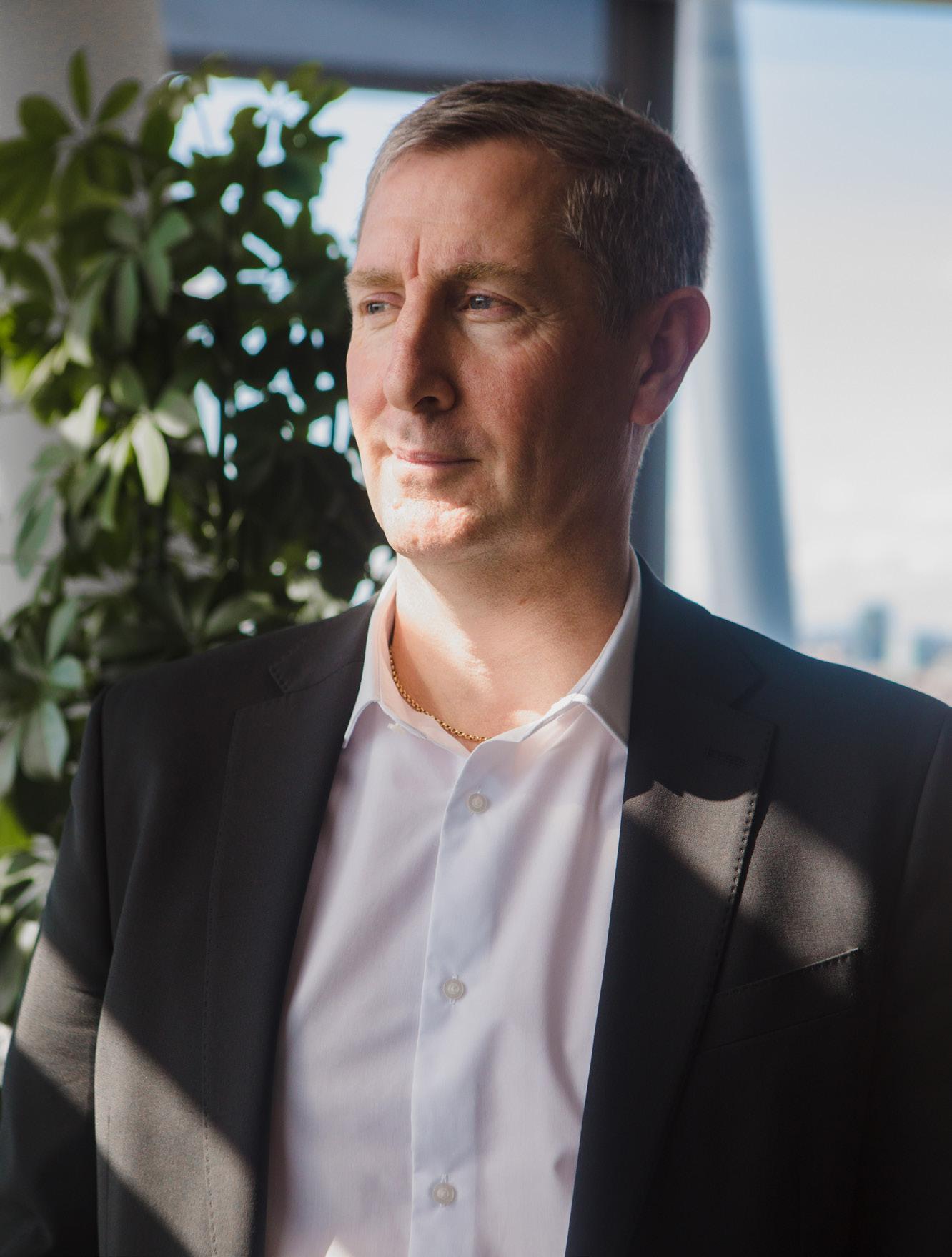
“IN
OF LIFE, EVERYONE’S GOT A RESPONSIBILITY TO TRY AND BE MORE SUSTAINABLE, IN WHATEVER FORM THEY CAN. AS A LENDER, WE’VE ALWAYS BEEN BEHIND THE GREEN AGENDA, AND WE’VE ALWAYS ENCOURAGED OUR CLIENTS TO BE MORE SUSTAINABLE”


While the development finance proposition was launched in 2016, Neal credits the division’s massive success to the bank’s acquisition of specialist lender Titlestone Property Finance back in July 2018, which propelled the bank into this specialist area. “Titlestone had a history of lending money on residential development, student accommodation and various other schemes that created homes. I believe the success of the division is very much down to that acquisition personally, because the Titlestone team has a very strong, knowledgeable, in-depth understanding of the market—they’ve been in the industry for over 30 years and have a lot of experience and great contacts. Bringing on board that team back in 2018, I think, was the segue into really moving and driving the business forward on development finance,” states Neal.
With several macroeconomic challenges that have hit the construction sector— including Brexit, the Covid-19 pandemic and the lingering legacy of the ill-fated miniBudget and Trussonomics—it’s no surprise that growth of the development finance business has come in waves, rather than having been a smooth ride. “We’ve definitely been on a bit of a roller coaster in terms of lending volumes but, in the past year, things have definitely picked up. The sales market is still a little bit slow at the moment but, certainly since the start of January, there have been a lot more enquiries and a lot more confidence, and that’s partly to do with pent-up demand,” he elaborates.
Amid the ups and downs, Neal believes Paragon’s £3bn lending success comes from one thing: focusing on providing development finance for the right deals for the bank. “We've always had the aspiration to lend into the market, and this always centres on making sure the loans are of good quality: if the deal is good, we’ll write; if it’s not, then we’ll say no to it. We're very rigid about how we look at things in that respect; it's all about making
sure that we're following the quality deals. Otherwise, you get into the inherent danger of focusing solely on a target and forcing yourself to write deals to reach a certain number, which later on become problematic—that’s not the way we roll,” he explains.
When it comes to funding the right development scheme, two things are essential for Paragon Bank: borrower experience and the built asset being fit for purpose. “It all comes down to knowing that your borrower has developed similar buildings before, and you can leverage off that experience. No two schemes are the same—there are always different challenges—but, fundamentally, if you've got people with experience who you can support, then you'll end up with an end product that can be either sold or rented. So a key element to success is knowing the customers, and that comes from the experience of the team leveraging off that,” he elaborates. As for what constitutes the right development to lend on, Neal points out that this all comes down to ensuring the asset being built is the right one for the area, meeting local buyer demand.
There is another key thing that has kept Paragon Bank lending continuously and helped it reach the £3bn milestone: a consistent and flexible proposition. “When Covid came through, some lenders paused things, whereas Paragon Bank continued to lend through that tough time. We’ve always had an appetite to support residential—whether it’s flats, houses, bungalows, you name it—we're open-minded about what we support, and we always want to make sure that we're flexible in our thinking. We always pride ourselves on being reliable and trustworthy—we’re always going to be there to support people if they do the right thing,” states Neal. This reliability and willingness to work with the developer has resulted in about 85% of the division’s business coming from repeat clients.
Of the £3bn lent by Paragon Bank to date, just over £180m was delivered through the finance provider’s Green Home Initiative—in total, 900 homes are being funded through this scheme.
The Green Home Initiative was launched in November 2021, with an initial £100m tranche of lending having been made available
“HAVING
BEEN IN THIS INDUSTRY FOR MANY DECADES, I KNOW THERE IS NO POINT IN JUST TRYING TO COMPLETE A LOT OF DEALS AND TRYING TO ACHIEVE A NUMBER IF YOU DON’T DO IT SENSIBLY”

to developers looking to build energy-efficient homes. Through this scheme, any developer delivering housing with an EPC rating of A is eligible to receive a 50% reduction on loan exit fees—to qualify, at least five private units must be built within the development and 80% or more of these must have an EPC rating of A, with any remaining meeting at least the EPC C standard.
Since the launch, the funding pot allocated by the bank for the Green Homes Initiative was increased twice—to £200m in 2023, and £300m in April this year— and a total of £183m was committed by the bank, which, according to Neal, demonstrates the popularity of the scheme. “Clients like the product and, sometimes, this can be the difference between us winning a deal or not. This is not what we’re doing the scheme for, but it ends up having a mutual benefit for us and the borrower,” says Neal.
The bank launched the Green Homes Initiative to drive sustainable, positive change in the built sector. “In all areas of life, everyone’s got a responsibility to try and be more sustainable, in whatever form they can. As a lender, we’ve always been behind the green agenda, and we’ve always encouraged our clients to be more sustainable. We brought the Green Homes Initiative in because of the future net-zero requirements and to make sure that homes are built more sustainably. We’re just trying to encourage developers to build more green but, ultimately, it’s their choice,” Neal elaborates.
Going back to the creation of the Green Homes Initiative, Neal tells me the scheme was specifically designed to support developers with the funding they need but not making it too easy for them to get discounts, so they have to put work into it and show their commitment to delivering green homes.
The other key thing to a successful green finance product, in Neal’s eyes, is not overcomplicating the product with complex lending criteria. “It’s very much about keeping it simple so people can understand it.”
However, as the way in which sustainability in the property sector is measured has changed since the scheme was launched three years ago, Paragon Bank is now analysing the deals it has completed to see how developers are faring with the requirements, and assess whether the criteria for the Green Homes Initiative needs to be adjusted to better reflect the current environment. “As we’re seeing schemes being completed, we’re getting to the point where we can see if developers can clear those hurdles or not. So this is under review to see if it is fit for purpose, because we don’t want to promote something that’s
not achievable—that’s pointless.”
When it comes to green finance in the construction sector, developers do not necessarily have a cornucopia of choices to choose from. While some may argue that creating a meaningful green development finance product can be difficult, Neal disagrees, claiming that this is fairly straightforward. “It all comes down to whether the organisation wants to support that kind of thing, because what they’re really doing is giving away some of their profit,” he states. “Sometimes, you have to accept a lower return to help drive something meaningful.”
Looking ahead, the bank is already working towards the next natural milestone—reaching £5bn of total lending. The way it aims to do so is twofold. First, the lender will be expanding its team with new recruits to increase its regional reach. “One of the things that we probably haven’t been as successful in as we could is lending in the North West—that’s an obvious place for us to grow our team,” the managing director states.
Secondly, the firm is continuing to carry out research and analyse the market to identify areas of opportunity, with the intention of creating products tailored to specific markets where Paragon Bank feels there’s a funding gap they can fill—for instance, the PBSA and BTR markets, which Neal recognises as potential growth areas for Paragon’s development finance division due to the increasing demand for these types of schemes.
Nonetheless, Neal clarifies that the firm is not putting any time pressure on itself to reach this target within a set number of years, instead choosing to focus on growing the business sustainably. “Having been in this industry for many decades, I know there is no point in just trying to complete a lot of deals and trying to achieve a number if you don't do it sensibly, because the worst thing that's going to happen is that a number of those deals will go wrong. That creates problems and a lot of work to fix them, and it might even create losses. It's nice to have targets, but the timeframe of reaching the next lending goal is very much dependent on whether they are the right deals to do, rather than whether we should seal a certain number of them.”








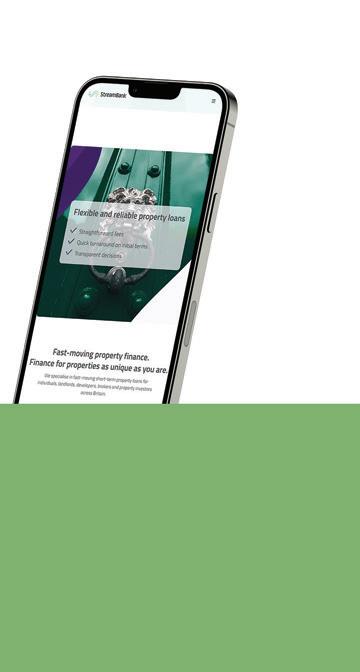


‘Our aim is to build a platform where we are seen as a provider of support and education, helping accelerate developers on their net zero pathways’
In February this year, Puma Property Finance launched a new Impact Lending Framework, established to provide direct financial benefits to property developers across the UK who are implementing measures in their vision and designs that deliver meaningful and impactful change. This framework sets out criteria under which prospective development projects can qualify as an impact loan, with borrowers receiving a fee reduction on final repayment of the loan if their schemes qualify.
Sarah Milne, head of impact at Puma Property Finance, talks to us about the roll-out of its new Impact Lending Framework, the lender’s ongoing commitment to driving sustainability in the built environment, and what’s in store for the future


What inspired the launch of the Impact Lending Framework?
The path to net zero and growing social inequality in the UK still present huge challenges, and we believe that property lenders are uniquely placed to incentivise the adoption of more sustainable and impactful practices within the industry. As a business, we’ve always considered community, social values and our environmental impact— these were brought to the forefront a few years ago with the introduction of our ESG and values committees within our wider business, Puma Capital Group.
As part of our commitment to driving sustainability, we’ve been working in partnership with UCL’s Bartlett School of Sustainable Construction since its inception in early 2023 on research into more sustainable practices within the built environment. Fundamentally, this inspired us to consider how we could do our bit to drive more change within the sector, and it all went from there!
What was the journey like to get here?
The launch of our Impact Lending Framework at the start of 2024 came following a three-year evolution of our ESG strategy. This included countless conversations with our professional networks, developers and advisers to find out what was important to them, the collection and analysis of ESG data across our loan book (within our internally produced ESG scorecard) and our partnership with UCL.
One of the key things in helping us to get to this point was building from within. The Impact Lending Framework was a passion project for me and other members of the team, so rather than bringing in outside resources, we formed a team of people who knew the business—and our industry and clients—inside out. Once we began developing the framework, we understood the importance of bringing in respected third-parties, like JLL and Sintali, to help enhance the offering, as well as to provide independent verification through industryaccredited measures to deliver authentic and meaningful change.
What was the process and the logic behind the specific criteria that developers must meet to qualify for the discount?
From the outset, we were certain that the framework needed to be objective, subject to third party independent verification and deliberately ambitious to achieve. The framework utilises well-established
certification schemes for the sustainability criteria—NextGeneration for residential and EDGE for commercial—while the social criteria utilise government data on the Indices of Deprivation for the appropriate country or, in the case of residential schemes, they could achieve the ambitious social criteria for delivering 50% affordable units on site.
What were the biggest challenges Puma encountered when creating this framework, and how did you mitigate them?
One of the biggest challenges was creating a framework that catered to the range of developments that we fund, both in terms of asset class and development size. We approached this by splitting the framework into residential and commercial criteria. From there, to ensure it was suitable for the developments we fund (GDVs of circa £15-100m), we focused on reducing the barriers to entry, ensuring it was easy to understand and low cost to implement. We needed the certification scheme to apply to different asset classes while ensuring the fee reduction (circa 1%) and the benefits to borrowers remained the same.
You’re offering a material fee reduction of up to 1%. What is the benefit to Puma?
We want to encourage and promote sustainable developments that deliver the criteria set out in our framework—it is stretching, but achievable. Our aim is to build a platform where we are seen as a provider of support and education in helping accelerate developers on their net zero pathways. Yes, we are giving away fee, but it’s part of a bigger end goal—impactful lending. We’re already a relationship-based lender, with 50% of our lending going to repeat clients. Surprisingly, it’s not that common in this industry, so we hope by seeing them through these barriers to entry, we can further strengthen those relationships and deliver even more schemes together.
How has the market reacted so far?
We’ve had really great feedback—from, “this will assist in establishing our own ESG strategy” to, “this has prompted us to start measuring and tracking our data properly” and, “this has made us think more about the forecasted operational emissions of our developments”. The aim of the framework was to provide a clear, streamlined approach, that gave access to third-party advisers where required and is designed to encourage
the delivery of more sustainable or socially impactful development through the provision of financial incentives. This seems to be translating well based on the conversations we’re having with the market, and we have a number of borrowers currently considering the framework and applying for a loan.
How much has Puma lent under the framework, and what lending targets do you have for the framework in 2025 and beyond?
We are delighted to have closed several loans already where the Impact Lending Framework has been included in the facility agreements and those borrowers are actively working with third-party partners to progress the framework criteria. We will, however, not be reporting on any loans under the framework until each scheme has achieved its independent third-party certification, which is the verification that the Impact Lending Framework criteria has been met.
How do you see the framework evolving?
We’re actively engaging with our network to drive the conversation around ESG, and the framework is something that we expect to continually evolve as we have more and more of these conversations. For now, we are getting the message out there and challenging developers’ perceptions around how they can implement change or consider their social and sustainable impact. This means we’re asking questions like, “What would make you consider design changes to enhance the sustainability of the scheme?” and, “Do you need to be introduced to advisers who can help?” Clearly, the framework is delivering a material financial benefit to developers, but we also want to provide support and assist in breaking down the barriers to entry, be it through engaging more partners or dedicating more resources. Despite the ongoing headwinds impacting the market, this is something that remains at the forefront of our business because it really matters to us. We’re trying to be a better version of the lender we were last year, and the year before that, and encourage better behaviours within the sector.
In your opinion, what simple steps could lenders take today to make their businesses more sustainable?
Firstly, start by considering the ESG risks and opportunities for your business, stakeholders and customers, what is most important
to you and where you feel you could have the most impact. The second element is collaboration—speak to other professionals and lenders. As an industry, I think we’re generally not talking to each other enough; engaging at any level is a good way to start and acknowledging that there is no such thing as perfect. It’s worth bearing in mind that an ESG strategy is transitional.
When creating a new product to encourage green building, how does Puma find the balance between making the lending criteria specific enough to make a difference in terms of sustainability of the end product, but not too complicated so it doesn’t put off developers who may not fully understand complex sustainability measurements?
There needs to be an acknowledgement that it isn’t feasible to have an ESG framework that is able to capture everything—ESG is vast in its nature, which can in itself create a significant barrier to entry. We therefore focused on simplicity, so that each of the certifications were ambitious enough to stretch our borrowers, but also only have to achieve a single criterion to qualify for the fee reduction, as opposed to having to tick multiple criteria. This streamlined approach not only makes it easier to understand for our borrowers, but also to measure what is being targeted and achieved. For example, EDGE green building certification focuses on doing three things very well—energy, water and embodied energy in material. To achieve EDGE certification, a scheme will deliver standards across these three elements as a minimum, and a 20% improvement to local building regulation standards.
How difficult is it to innovate in the green/sustainable development finance sector and come up with new products that make a difference?
Without doubt it’s challenging, not least due to the extensive amount of ESG metrics or measures that could be utilised. It is also a challenge to balance the ambitious criteria that is driving real change in schemes being delivered and a significant enough financial incentive for borrowers to engage. However, setting the bar too high with unrealistic criteria for developers to achieve means the financial incentive would not offset the costs or bring changes that would need to be implemented.
“Despite the ongoing headwinds impacting the market, this is something that remains at the forefront of our business because it really matters to us. We’re trying to be a better version of the lender we were last year, and the year before that, and encourage better behaviours within the sector”



WE LEND OUR OWN FUNDS
In the last 24 months, we have deployed and committed more than £100m of our own funds across England, Wales and Scotland. Contact
Loans from £500k - £5m
Terms within 48 hours
‘Urgent’ 5 Day Capabilities
Ground up Deveopment
Land with Planning
Developement Exit No interest deductions
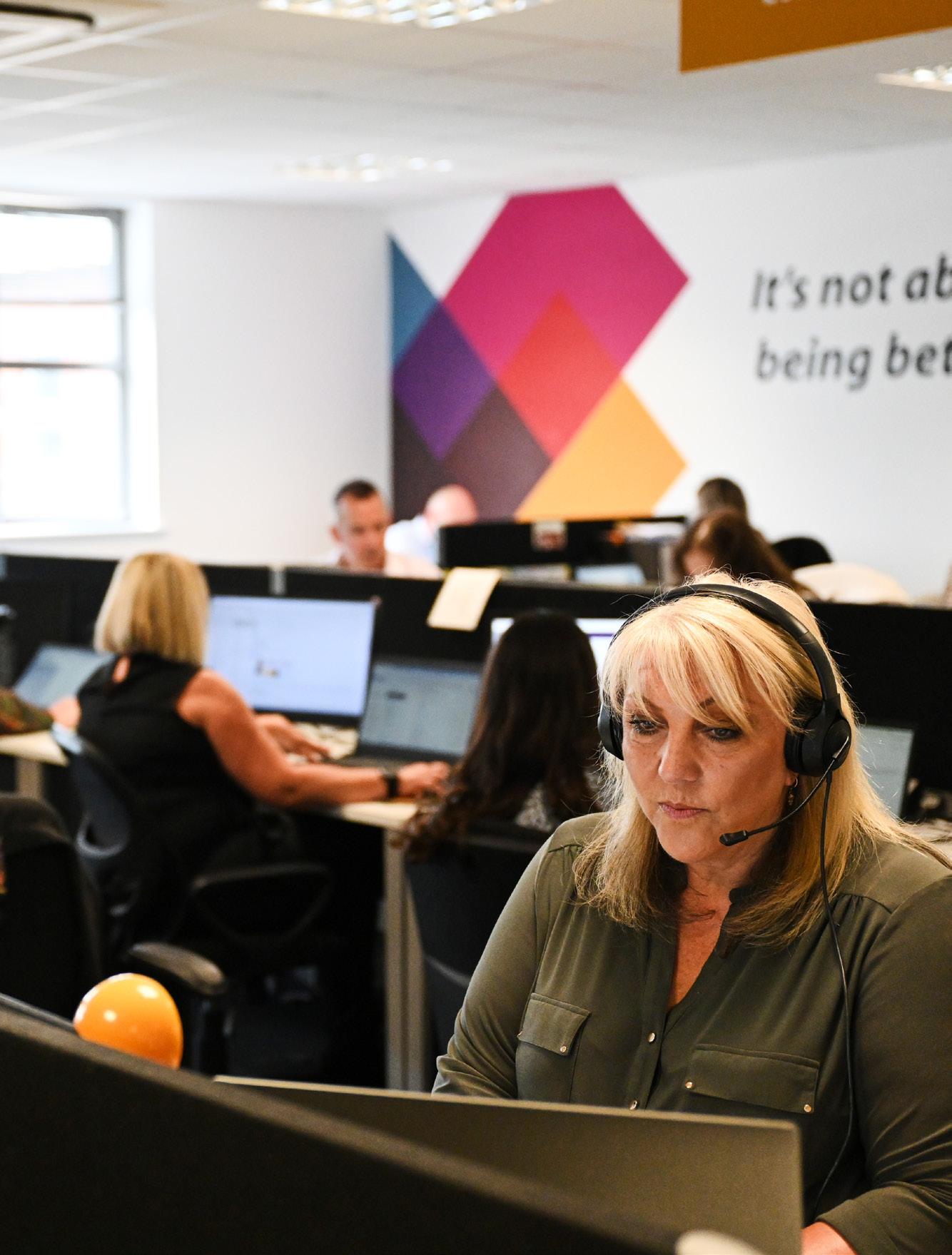
In a quest to learn more about Crystal Specialist Finance, I set out on a journey to the firm’s headquarters to speak directly to its team about what it takes to keep the wheels of this specialist distributor turning
Words by ANDREEA DULGHERU

n a bright Wednesday morning, I find myself at a very different spot from my desk at Medianett Publishing in London. I am, in fact, in Tamworth, northeast of Birmingham, at Crystal Specialist Finance HQ. Greeted by group sales director Jason Berry and HR manager Tara Hanratty, I am taken to meet the team and learn all about the company’s ins and outs.
I start my day at the sales department—or as Crystal’s intermediary sales director Dan Morris calls it, the ‘first responders team’. Currently there are nine members in the intermediary sales division, including Dan, three BDMs, four telephone account managers and a sales support manager, who are led by Jason.
As the moniker suggests, this team is here to offer support to brokers in arranging or placing deals. “Our job is to help brokers in tricky situations,” Dan says.
Each role entails slightly different day-to-day activities. The telephone account managers are tasked with contacting, building relationships and staying in constant communication with intermediaries. “Ultimately, their job is to reach out to the broker and engage with them at least once a month, to make sure they’re doing well, find out how their business is doing and what support they need, and tell them about any exclusive products we may be able to offer,” Dan details.
Meanwhile, the BDMs focus on the repeat customers who bring regular deals to the Crystal desk. “No two days are the same, and that’s what I love about the job the most,” shares Samantha Pettit, one of Crystal’s BDMs. “Most of the role is being on hand for our broker partners and guiding them past any bumps in the road, answering
questions, and meeting up to talk about what support we can provide to give them as much opportunity to work in this market as possible,” she explains. “Things change, not only in the market, but also personally for brokers and their businesses, so it’s nice to see how they’re evolving and how we can help, whether that’s with more education, specific products etc.”
As for Dan, his duties revolve around building and nurturing relationships with mortgage organisations or bigger client accounts, as well as assisting the sales team. “I wear many hats, from sitting in the office training colleagues to meeting intermediary networks and clubs. It’s a very diverse job— there’s always something going on that’s different, interesting and fun.”
Aside from showcasing the services Crystal can offer (for both packaging deals and handling referred cases entirely on behalf of intermediaries), a priority for the sales team is increasing brokers’ knowledge about the overall specialist finance market and the latest trends and developments, plus showcasing how different types of specialist products could help their clients through direct conversations or webinars created by the company.
“A huge part of what we do is education,” affirms Samantha. “A sale starts with the broker and their conversation with the borrower is essential, so teaching them about specialist finance and helping them
to understand the various options available is key. We’re providing brokers with the tools to be able to have those talks and offer their clients specialist products so they can get more business. That’s why we’re here—because we’re experts in this field.”
This reflects Crystal’s customer-centric approach. Equipped with a more intricate knowledge of this sector, brokers can expand the range of business they receive, while getting Crystal’s support on more complex cases, if needed—a trend that the specialist packager has already noticed. “About 37% of brokers we have spoken to over the past 12 months said they’ll get into commercial finance to diversify their business. What we can do is hold their hand for the first few cases, and if they later opt to go directly to lenders, that’s absolutely fine. But we’re finding that they prefer our service and want us to continue helping them with their deals, because of our relationships with the lenders,” imparts Dan.
It is this desire to assist brokers with whatever they need—be that education or guidance through deals—that the Crystal sales team believes sets them apart from other packagers, and has led to much success over the years. “We work hard and we enjoy what we do, and as long as the broker and the borrower are happy, then we don’t need a pat on the back. We don’t boast about how brilliant we are, we prove it,” Dan states.

Next, I am introduced to Satwant Bhandal— or Sat, as everyone calls him—the firm’s corporate sales director, who also reports into Jason.
Sat’s role was born out of the wish to expand Crystal’s reach to other experts working in the property sector, using connections to the full to get more direct business. With the extensive network he had built over more than a decade in his career in banking, Sat was the perfect person to steer this ship.
Sat’s job centres on fostering relationships with all types of real estate experts and people involved in property transactions—lawyers, accountants, developers, even friends of existing or previous borrowers—to identify if any require specialist finance and pinpoint how Crystal can help to make this happen.
This wide contact network, thus the opportunities to secure a variety of business it presents, results in a bigger pot of deals being handled by the division. “Our average loan size is a fair bit larger than what we’d have in the broker-led space—in the latter, we’d look at anywhere between £250,000500,000, whereas in the corporate space deals can start from £500,000 to £2m or more,” Sat explains. “It’s limitless, because the market is huge—any accountant, solicitor, developer, HNWI, tech entrepreneur and anyone else looking to buy a residential, commercial or BTL property, or wanting
“We’re providing brokers with the tools to be able to have those talks and offer their clients specialist products so they can get more business. That’s why we’re here—because we’re experts in this field”
“We have a responsibility to listen to our people and enact their wishes, and that’s what we do. For us, success isn’t about the bottom line— if you’re a good employer and a good supplier of the services you’re providing, the profit comes naturally”
to build something, is a prospective client.” With such hefty average loan sizes, it’s no surprise the corporate sales division’s pipeline is around the £60m mark, with an additional £30m in the works.
While the potential for new business may be boundless, turning leads into fully fledged deals is a multifaceted and time-consuming job—one that Sat absolutely loves. “I’m constantly on my game. In the evenings, I’m on calls all the time, because that’s primarily when my client base is alive. My clients are busy running their businesses during the day, and want to sort out their property stuff in the evening or at night, so I’m always on calls between 4pm and 8pm, which gives me time during the day to be out networking, attending events and talking to other people.”
With corporate sales currently a one-man band, there’s no denying Sat’s job involves a lot of work, particularly as he must balance lining up new business with managing the deals he’s already got. “There are 15 deals of any size and complexity going in a week, so I need to stay on top of all that, while getting out and networking with potential clients. If you don’t do the latter and you’re not putting in the new stuff, you’ll run out of deals in three months’ time,” he claims.
Regardless of the number of clients or magnitude of the loan, Sat’s practice mirrors that of the intermediary sales team and the
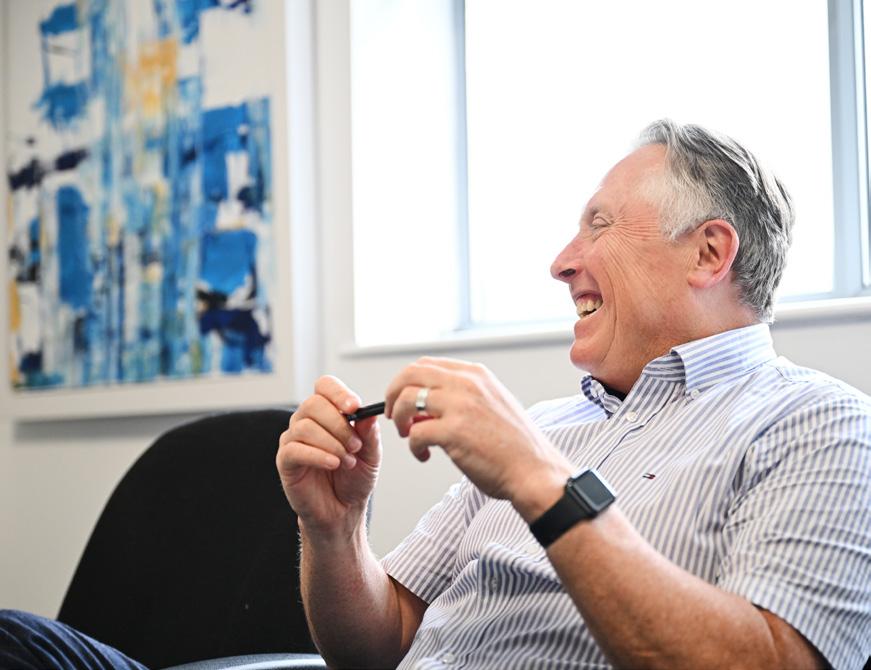
wider company: prioritising customer service and wellbeing above all else. And while Sat and Crystal are always eager to help a customer with their deal, they will not force a partnership between a client and the firm unless it is exactly what that client needs and wants. “You can only lead a horse to water; you can’t make it drink,” he says. “It’s the same here. We have a no-pressure approach, and I think we do a lot more business on the back of that. We’ll give borrowers advice, offer options at the best rate we can, and we don’t charge them for that. If we can do the deal, that’s great; if not, that’s no problem,” Sat insists, adding that transparency and honesty are at Crystal’s core.
“As I tell people within this firm all the time, we don’t actually sell a product, we sell a service. Buying a property is probably the third biggest and most emotional milestone for a person, after marriage and having kids, so our job and our goal is to make sure we secure their mortgage in the easiest, most streamlined way possible, and that the client and the end borrower are happy,” he adds.
Once the broker has spoken to the sales teams about a deal, the case gets passed to Crystal’s mortgage desk—this is also where any deals directly submitted by intermediaries or clients through the firm’s
online platform CrystalHUB land in the first instance.
“If we’ve got a new enquiry that’s more tentative or complex where we need a bit more information to understand the deal, it will come to me or my colleague Greg Grant,” explains mortgage desk specialist Charlie Clarke. “While the sales team is managing the relationship with the broker, we’re trying to get a better idea of how the deal may be structured and what the rate might be. Essentially, what we’re doing here is getting a better understanding of the case.”
Once a deal comes through, the mortgage desk calls the broker or client within an hour, to establish whether this is something they can take on and how it might shape up. “It’s really about having positive conversations with the clients, seeing how we can help and add value—particularly for deals that brokers aren’t comfortable with—and seeing if the deal needs to be structured a bit differently, or offer an alternative perspective, so we can ultimately say yes to it.” Any intermediaries with an urgent enquiry can also directly call the mortgage desk to speak to Charlie and Greg.
As soon as all the details are confirmed, the mortgage desk will fill in the required information on the CrystalHUB during the call, to ensure the deal is handled as quickly as possible.
From this point, the deal swiftly moves to Crystal’s underwriters, who will speak to the intermediary or the direct borrower—if the case has been referred to Crystal by the original broker—to get an in-depth overview of the borrower’s needs and circumstances and, if the broker has had the deal declined, to ascertain what the problems were that led to this.
“We’ll then talk to a few lenders to see who can take this deal on board, and also to find out which one can offer the cheapest rate, then we’ll come back to the broker with some initial terms, which is where our quoting system comes in,” details John Barratt of the underwriting team.
For packaged cases, the quote provided by the underwriter goes directly to the broker who submitted the deal, who is then required to pass it to the borrower to make a decision. For referred cases, the underwriters will be in touch directly with the borrower to provide the quotes, and offer advice on the best option for them, as well as field any questions they may have.
“We sometimes get people asking for a better rate; some people have it in their heads that packagers will put you with a lender that’s more expensive because it’s easier for them. However, we don’t do that—we give people the best rates we can get them for their circumstances from the beginning,” states underwriter Marney Hill.
Currently, the team comprises five underwriters and one senior assistant, who are led by Crystal’s new business director Toby
Breeden. Within this department there is also a referrals team—which handles all referral cases placed by intermediaries—of three mortgage advisers.
Each underwriter focuses on a specific specialist finance sector. “By having people who specialise in one area and who know all the lenders in that space, the deal gets handled as quickly, easily and efficiently as possible. Plus, lending criteria always change, so you can’t fully keep up with this for all types of finance at once,” Marney notes.
Once the broker or client selects their funding option from the quotes, the case goes to the loan processing team—17 members led by operations director Kris Corns—who are responsible for taking the deal to completion.
As with the underwriters, each lending manager specialises in specific specialist finance sectors, and handles deals that fall within their areas of expertise.
Sarah Swindell, lender relationship manager for term finance, tells me what each team member does with every case they receive, from speaking to lenders to conducting the due diligence: “We’re responsible for setting up the case and doing the Land Registry searches, credit checks etc, to make sure it is workable. We then do the admin right through to completion, and we’re in constant contact with the lenders to get their requirements list and fulfil it. It’s our responsibility to collate all the documents and package the deal for the lenders, so they’re happy to issue the decision in principle and complete the case,” she elaborates.
The loan management team can also get involved again close to the end of the

deal’s term, if a broker approaches Crystal for additional support for their client to remortgage or if the borrower requires additional finance. “Ideally, the deal will go to plan and the borrower will redeem within the term, get a mortgage or sell the property and move on. However, in the past 12 months, the massive jump in interest rates has affected borrowers’ ability to get a mortgage, which can really impact their exit plans. At that point, we could see if they need a bridging loan to buy more time, for example, or anything else,” says lender relationship manager Stuart Cullum-Machin.
Aside from its mantra of supporting clients, Crystal prides itself on looking after its own people—and there is one person leading this wholeheartedly: Tara Hanratty. Tara started as an executive assistant to managing director Jo Breeden, but her passion for taking care of people quickly led her to her current role. As the company’s HR manager—or ‘the office mum’, as she describes herself—Tara focuses on all things related to the staff, from handling recruitment to ensuring all team members are supported each day. She also organises company activities, including the annual Crystal Ball and the company’s family day each year, when the whole team and their families come together for fun activities. “Buying and selling property is stressful in general; brokers and clients get stressed, which then translates to our staff. My job is to see how we can mitigate this and make sure the employees are not taking all that on themselves. This is how we keep them happy,” she asserts. “We’re like a family here, and the culture is really important to us.”
This caring approach comes in many forms and is driven by the employees themselves. Tara tells me the managers have weekly and quarterly check-ins with their team members to see how they are coping with their workload, how they are feeling physically and mentally, and if they need extra support. “All our line managers have mental health training. People have a lot to deal with in their lives, like grief, divorce and much more, and if you’re managing them, you’ve got to be able to help them with these things.” The company also has a wellbeing page, directing staff to any resources they might need, and Tara runs a Wellbeing Wednesday initiative, sending out a midweek newsletter with information about how people can look after themselves. In the wider realm, Tara, together with Jason, was a key player in the creation of the Mortgage Industry Mental Health
Charter. This started during the pandemic, when Crystal was concerned about its staff during the lockdowns and wanted to ensure they were okay through this tough time. “I was working on things internally, and Jason was doing things externally with brokers on mental health, so we thought it would be great to put something in place for the whole business,” Tara shares. After piloting a programme with a university in the Midlands, both Tara and Jason realised its potential for the specialist finance industry, and decided to take it further. Thus, with the collaboration of other firms in this sector, the charter was born.
All of Crystal’s initiatives have one key goal: to support its staff and create a culture where each member feels valued, respected and taken care of—a message that everyone here lives and breathes, including the directors. “Jo is a very open person— he’ll often wander around and make you cups of tea while you’re working—and so are the managers,” Tara says. “That camaraderie is built into the onboarding as well. When people start a job with us, they sit with everyone in the business, learn who everyone is, and we have regular get-togethers where there’s no hierarchy. We’ve got lots of people our employees can go to if they need to talk. We’re a team and we care about each other.”
From the conversations I’ve had today, there’s no denying that Crystal’s ethos is taking care of people, both staff and customers.
Sitting down with the firm’s senior management, it’s crystal clear (pun intended) that this message and the nurturing atmosphere trickle down from the top, starting with the company’s MD, who emphasises the need to listen and nurture your staff: “We are a people business and we invest in people,” Jo confirms. “We have a responsibility to listen to our people and enact their wishes, and that’s what we do. For us, success isn’t about the bottom line—if you’re a good employer and a good supplier of the services you’re providing, the profit comes naturally.”
This is combined with transparency and open communication at all levels, to ensure everyone’s voice is heard. “It doesn’t matter whether you’re the cleaner
or a board member, we let everyone have a say. We’ve all got power to say anything; there’s no stupid suggestion or question, we want to hear it,” Jo adds.
The senior team also uses data to identify potential market trends and anticipate where extra support may be needed. “We look at the type of business coming in, and where that’s forecast to go, so we can get ahead of people’s workloads and make sure they don’t get overloaded. This is topped by the input from the staff. Someone might have 30 cases and be absolutely fine, whereas someone else might be swamped with the same number of cases, because they’re much more detailed. Data is one element, but that human approach definitely forms a big part of it too,” observes Kris.
Putting people first seems to be the winning ticket for Crystal—Jason confirms that since the pandemic, the firm has seen growth each year. Currently, it is on track to do over £1.2bn worth of applications (with bridging, commercial and BTL finance making up 80% of this volume), and by the end of 2024, Jo expects business to increase year-on-year by at least 6%, possibly 10%.
I am told the company has also seen a significant rise in referred cases, from brokers who may be part of networks and are not allowed to write specific specialist finance loans or from intermediaries who want to diversify their business into this area but don’t have the expertise to handle these cases. “A number of advisers want to deliver a holistic solution, but realise they’re not equipped to do it themselves. We're seeing more referrals than we've ever had before, because brokers are recognising they can't be an expert in every advice space, but they can partner with a business like Crystal who operate with the highest level of service values. The certainty around the initial placement and getting the case funded even when obstacles occur during the process are the magic dust which set us apart” says Jason.
Kris and Richard Bond, the firm’s head of compliance, agree, adding that the team’s extensive experience is central to Crystal’s appeal. “This is where our skill set is—the guys know how to navigate things to get to that solution. This is the real value-add we provide, and what’s allowed us to grow to the current level and gives us the potential to grow further,” Richard states.
And Crystal is determined to keep the momentum going. Aside from being constantly open to recruiting more people
depending on the company’s needs, a particular area of focus is increasing the amount of repeat business it gets from its broker partners, which has risen from 5% to 40% since Jason joined in January 2020. Above all, the firm’s main priority is continuing to take excellent care of its staff and customers, and delivering valuable education to brokers to support them every step of the way, and help them complete more business. “We want to be the clear choice for any broker or introducer who has clients with specialist finance needs, but also be recognised as a respected employer who is considered an educator within our sector. There’s plenty of opportunity, and we’ve just scratched the surface,” concludes Jo.

“We work hard and we enjoy what we do, and as long as the broker and the borrower are happy, then we don’t need a pat on the back. We don’t boast about how brilliant we are, we prove it”


Mentorship has a great power to develop talent and support staff, including in our market. However, we can all agree that mentorship is not a one-size-fits-all approach for both mentor and mentee. So what better way to learn more about the magic of mentorship than to hear directly from some of the top people in the industry and get their insight and their experience of being both mentors and mentees?
This idea crossed our minds when we started discussing mentoring in the July/August issue of B&C Magazine. The feedback from readers, mentors and mentees alike has been incredible, and it just reinforced our beliefs: that it is important to shine a spotlight on different industry role models’ approach to mentorship and highlight their own experiences of learning the ropes from their own mentors to further drive education in this market and make the specialist finance industry a better place. It is an honour and a joy for us to be able to do this through our articles.
Continuing this insightful series, we have none other than industry heavyweight Marc Goldberg, commercial CEO at Together, joined by two of his exceptional mentees: Together’s chief commercial officer Ryan Etchells, and corporate relationship director Ben Storey. The trio talk to us about their personal experiences of being mentees, the key role and responsibility of a mentor, and why being humble and honest will do wonders for the mentor-mentee relationship.
Andreea Dulgheru: Marc, you had the opportunity to be mentored by Henry Moser from the beginning of your career. What was it like having Henry as a mentor and what was his mentoring style?
Marc Goldberg: Henry is a man who is still hugely passionate about lending, doing business, service and relationships. You cannot underestimate his knowledge, expertise and thought processes. Having Henry as a mentor is a great thing, and I am the success I am because of him teaching me and giving me the ability to do a lot of things, which many other people wouldn't have done.
AD: What have you learned from Henry and how did that shape your own mentoring style?
MG: He’s taught me one essential thing—LTV is key in a lending business. This has probably helped Together survive four recessions, while some of our competitors did not. He taught me not to go chasing business just for the sake of it—you’ve got to have the right credit risk, lending appetite, LTVs, income and affordability. He is definitely somebody who still keeps you on your toes. He is an incredible leader of this business. However, one of the things I had to learn on my own was how to get the best out of people, and how to deliver a message to somebody, whether it’s a customer or a colleague, in the best way for them. You can’t have a blame culture in the business—if you blame people, that brings out the worst in them. We have a family culture here at Together, and I believe every single person at Together gives 110% to do the right thing. However, we’re all human and we make mistakes but, if you’re really supportive with someone when you feel that they’ve made an error, they react far better.
I saw this first-hand about 10 years ago at a board meeting. We used to have a commercial board, and a colleague who worked for me. That board meeting was probably the worst one I’ve ever been to. Before, I used to get very frustrated by people’s mistakes and was a shouter—it never got personal though. But, after that board meeting, when my colleague asked me how I thought it went, I took them in the side office, and said, calmly and honestly, that I was really disappointed with their performance. I said I felt the quality wasn’t where I wanted it to be, we didn’t have the information we needed and I felt let down and disappointed. The colleague’s reaction was to burst into tears, which made me really worried, because I didn’t shout and I had tried to be really supportive. When I asked why they were upset, they said, “I expected you to scream and shout and, because you haven’t and you’ve been really articulate with your feedback, I feel really bad. I’m sorry I’ve let you down, it will never happen again.” I can tell you, from that day forward, my board packs were the best, and that colleague never let me down again. A big lesson for me that day was that if you are supportive and communicate really well when you’re giving bad news to somebody, if you're giving examples of where you think, potentially, they’ve gone wrong or what they could have done better, people react far better to that than anything else.
“The beauty of being a mentor is recognising people who have got a skill set that I don’t have or that I’m not very good at, understanding why that’s needed and important, and helping people develop that skill”
AD: Ben and Ryan, what is it like having Marc as a mentor, and what did you learn from him?
Ben Storey: Marc’s always given me support and guidance, and invested in me to get me to where I am in my career at the moment. He’s always empowered me to make decisions and spent time to support me and help me navigate through complex situations, and that’s something I try to do with the people in my team as well. He also taught me to put the customer at the forefront of everything we do. I'm really fortunate to have Marc and

to be working with him on a daily basis even now, and to have done this through my whole career. That's just something I always look back on, and I tell people how fortunate I am. I've got young colleagues coming up through the business who see my career path and see the relationship I have with Marc, and they strive for that as well—to be successful and be a leader in the business, like he is. Marc’s always been very honest and transparent with me. When I could have done something differently, Marc will provide me with a bit more guidance and support on how I could have handled that situation better. I've really tried to install that in my team—we don't always do the right thing, and it’s about how you approach that situation and manage those conversations with customers and internal stakeholders as well as how you’re bringing them along the journey. You've got to be honest and transparent with everything that you do, and I feel I've really tried to ingrain that in my management style with my mentees as well.
Ryan Etchells: When I first came to Together in 2007, Marc was probably more of a teacher than a mentor. He would show me how to do business, how to look at a deal, and how to engage with the outside world. He was teaching me the business the way he thought should be done and the way that he did things. However, when I joined the firm again in 2021—after I left in 2012 to work for a different company—I noticed that he had evolved into a mentor as well as the development in the way that he approached things. An example of this would be something that happened very recently, after an executive committee meeting. He came up to me and told me, “Ryan, I noticed that you’re at your best when you are in control of a conversation and when you’re explaining your recommendations, what the benefits of these are, and your role in these decisions. However, what I saw in you today was that you let other people lead that conversation and influence it, and you were out of control.” The two approaches were as different as night and day. Before, Marc might’ve come up to
me and told me about the technical things but now, with maturity, he was mentoring me and giving me feedback on my behaviours and specific points. That’s the bit I really noticed—the development in the way that Marc approaches things. Marc's probably the biggest success story in our organisation and probably in the industry that we’re working for—he has invested in himself and worked twice as hard as most people around him. The biggest lesson that Marc has taught me is that success is down to you. You have to invest in your career because no one’s going to do it for you. You're the biggest influence on your own career, so put the hours and the effort in and work hard.
AD: Do you have a key moment or lesson that defined your career and that showcases the value of Marc’s mentorship?
BS: The biggest thing was Marc telling me to be relentless every day. In addition to being on top of your work every day, it’s also about being resilient with your work, making sure you’re organised, and always being on top of things as something may come out of the woodwork. You’ve always got to be prepared and have clear communication with your customers, telling them where things are at any stage.
“You’ve got to be honest and transparent with everything that you do, and I feel I’ve really tried to ingrain that in my management style with my mentees as well”
RE: For me, probably the defining moment in my career happened in 2009 when I was working in underwriting. I'd been doing it for about six months at that point, and I’d got quite comfy with that job, if I'm honest with you, because I thought that’s what I wanted to build my career in. Marc wasn’t my line manager at that time, but he was my mentor and the person I was looking up to. I remember we were driving in Bury, and he told me that he needed to send me over to Heywood Finance—which was a car finance business within Together—because they needed someone to support them as they were struggling with the impacts of the credit crunch. Frankly, I was quite nervous
“I love when people are coming into my office and giving me their opinions and recommendations. I want people to come and take me on a journey. For me, I’m waiting for somebody to take my chair; that would be a success to me”

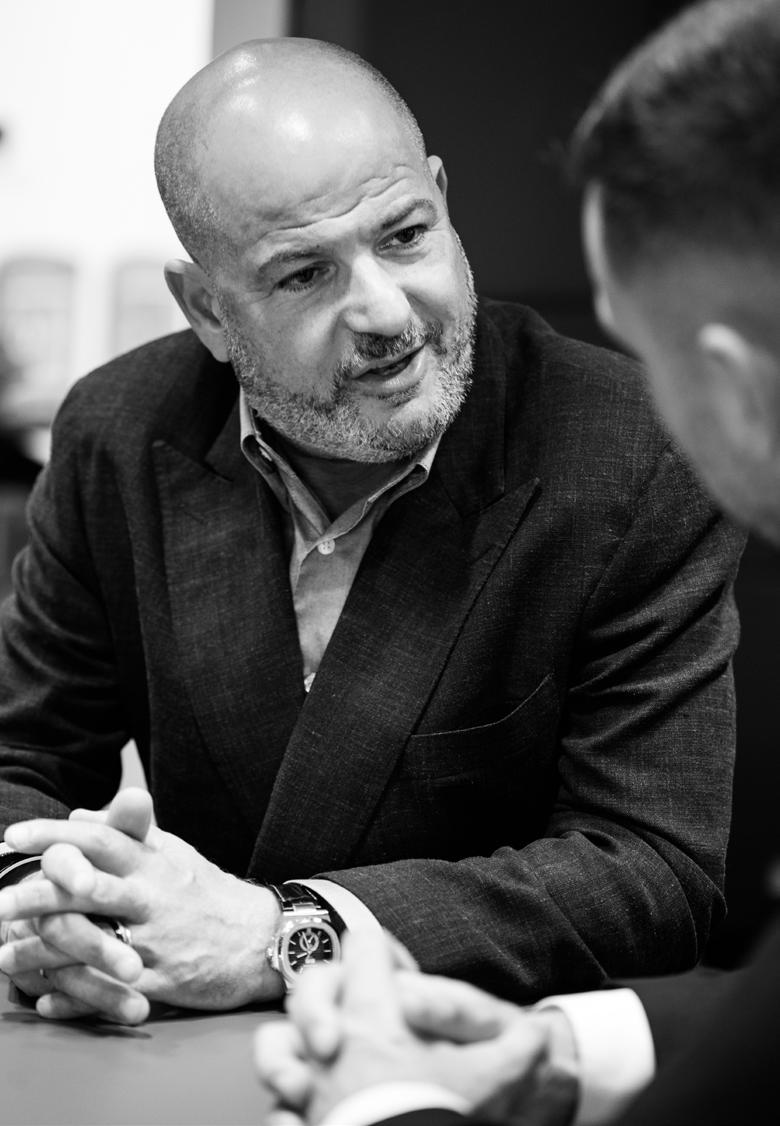
and scared to take that step and try to run a business—I was 23 years old at the time, after all. However, it was career defining for me. I think Marc had figured out that the job I was doing in underwriting was constricting me a little bit; I was getting comfy and it was not going to make me challenge myself. If I hadn't had that push from Marc, I probably wouldn't have done anything about it, and I might have still been sitting there doing the same job as back then. It was a sink-or-swim moment and it taught me two things: The first is that you don't always get someone who's going to push you into the deep end—you have to keep throwing yourself in this and challenge yourself so you can grow, the other thing is that, as a mentor, I should do the same for other people. When I’ve got people who I can identify—the same way that Marc did—as a big fish in a small pond, I’ll be the one encouraging them to do something different.
MG: At Together, we are defining people’s careers. We’re identifying the people who feel as if they’re at the stage where they’re a bit bored with their current role or think they can’t push themselves any more. Our responsibility is to identify these people and give them opportunities to grow, and we explain to them that you don’t always have to move up and you can move sideways. If you’ve got good people who give you 110% but are working in a role that’s not for them, then we’ll have a look at what other jobs we’ve got in the business for them and, hopefully, we’ll find their vocation and the right place they’ll love. We’ve got a young lady who has worked for us since she joined as part of our graduate scheme. As part of that, we used to move the graduates to different areas of the business every six months over the span of two years and, every time I put this employee into a different division, she went straight to the top. Later on, she went into
“The challenge for me was shaping up my own mentoring style. I didn’t have what Ben and Ryan had; they have had me and many other people mentoring them, whereas I was mentored only by Henry.
I’ve had to find my own way and my own mentoring style that incorporated not just the Together way but also what I thought was the right way to champion customers and colleagues”
“My advice to mentors would be to understand that their role isn’t to make their mentees a carbon copy of what they are. As a mentor, you’re there to help them understand how to improve their behaviours and how to be the best versions of themselves”
business change and, again, did a brilliant job, but I could see it written on her face that she had had enough; she was frustrated and needed an arm around the shoulder and guidance—and the beauty of being a mentor is identifying this and doing something about it. I remember getting her in the office and telling her, “Bear with me. Give me three months because, I promise you, things are about to change and you will benefit from this.” She stayed and now she is the number two in our business transformation division. This, to me as a mentor, is a great success, and watching her evolution to where she is today and seeing where she could be in the future is quite extraordinary.
AD: Would you say the ability to spot and recognise the talent in people is one of if not the most important responsibility and quality of a mentor?
RE: The easy bit is recognising something you’re good at and seeing it in someone else as well. I’ve got people on my team who have very similar skill sets to me, and that’s easy to notice. The difficult part—and the part that we as a business are good at—is recognising when people are good at things that you’re not, and understanding the value of that. There's no point in having 11 players on a football pitch who all do the same thing—some people are good at defending while others are better in midfield or the side. The beauty of being a mentor is recognising people who have got a skill set that I don't have or that I'm not very good at, understanding why that's needed and important, and helping people develop that skill. And a lot of organisations get that wrong and just end up developing the same cookie-cut people. However, what Marc, myself and Ben are good at is identifying if people are skilled in something that maybe isn’t your core skill set, trusting and investing in that talent and helping them grow. If you

“I’d advise mentees to choose their mentor carefully. It’s really important that you have that trust, transparency, and that ability to have a conversation with mentors who have no hidden agendas— they’re listening to what you’re saying and can help, support, and guide you”

do this, then you'll end up with a business that's got a multitude of disciplines. That's something that I think we're good at as a business.
MG: Yes, you've got to be able to recognise talent. But it’s also important to acknowledge that I have people who are better at doing certain things than I am. Ryan is far better at doing what he does than I will ever be, and Ben is much better at getting this team together, being calm and collected, and planning things. I also expect people to challenge me, but in the right way. You don’t want somebody questioning me and my decisions just for the sake of it. But I love when people are coming into my office and giving me their opinions and recommendations. I want people to come and take me on a journey. For me, I'm waiting for somebody to take my chair; that would be a success to me.
RE: It’s also important to stay humble. Having a big title in an organisation doesn’t mean you are any different from anyone else around you. You should always stay humble and keep your feet on the ground.
BS: Yes, I agree with Ryan. Never think you’re better than someone else. I feel like that’s why I’ve really connected with a few people around the organisation on how they can better themselves, hold themselves in the office and all sorts of things that will ultimately benefit their career.
AD: Having become mentors yourselves, did you ever feel the pressure to emulate Marc’s mentoring style?
RE: When you are in the early stages of your career, you may make the mistake of trying to become someone else—you see a successful person and you decide that’s how you’ve got to be and behave. It took me a couple of years—and Marc’s help—to make me realise that there’s no point in me trying to be like him, because that wouldn’t be genuine. Over the course of the first two or three years of my career, I probably did try to behave as Marc did and emulated the way he was working, but I figured out that
this was not me and not the way I behave, nor my skill set. You've always got to be your own person, and I’ve implemented that in the way I mentor people; I always make sure I instil in other people that they shouldn’t try to behave as anybody but themselves. You’re not trying to become the person you're looking up to; you're trying to take some positives from what they do, work on the parts of yourself that you're good at and become your own person. If you are yourself and work on your positives, you will add more value to the business.
AD: What would you say the biggest challenge of being a mentor is?
MG: I suppose the challenge for me was shaping up my own mentoring style. I didn’t have what Ben and Ryan had; they have had me and many other people mentoring them, whereas I was mentored only by Henry. I've had to find my own way and my own mentoring style that incorporated not just the Together way but also what I thought was the right way to champion customers and colleagues.
RE: The big challenge for me is finding the time to mentor people. We're all busy, and work, sometimes, is very demanding, and it’s disappointing when you can’t mentor your people. I'm currently mentoring a young lad and, the other week, I had to cancel a meeting with him with an hour’s notice because something else had come in my diary, and I felt terrible about it. The hardest part of mentoring is having and committing the time to do it, and making mentees feel they can have all the time they need to talk things through and get your input. That’s the bit that, to me, is always difficult.
“The biggest lesson that Marc has taught me is that success is down to you. You have to invest in your career because no one’s going to do it for you. You’re the biggest influence on your own career, so put the hours and the effort in and work hard”
BS: Yes. And I think, a lot of the time, you can lead the horse to water but you can’t make it drink. When I see this happen with one of my mentees, it makes me take a step back and think about whether I spoke to the colleague in the right way. People get engaged in different ways, and changing my own style to assist a colleague

who I'm speaking to is a challenge, and a big lesson for me is that not everyone’s the same. It's all about finding a style that benefits that colleague the most.
AD: Lastly, what advice would you have for mentors or mentees?
BS: For mentees, I’d recommend them to be a sponge, and just be open to anything. You need to be taking in everything that a mentor is speaking about, and the way they handle a conversation with other people. You just have to soak it all up as much as possible. Every day is a different learning day, and you’ve got to take advantage of that.
RE: My advice to mentors would be to understand that their role isn’t to make their mentees a carbon copy of what they are. As a mentor, you’re there to help them understand how to improve their behaviours and how to be the best versions of themselves.
MG: Personally, I’d advise mentees to choose their mentor carefully. It’s really important that you have that trust, that transparency and that ability to have a conversation with mentors who have no hidden agendas—they're listening to what you're saying and can help, support and guide you. As for my advice for mentors, they need to realise that this isn’t for everybody—you’ve got to give up a lot of time, and it can sometimes be frustrating. However, the fruits of being a mentor—watching mentees succeed—is the most amazing thing. If you do want to be a mentor, you have to put a lot of time into it and just be really honest with your mentees.I’d advise mentees to choose their mentor carefully. It’s really important that you have that trust, that transparency and that ability to have a conversation with mentors who have no hidden agendas—they're listening to what you're saying and can help, support and guide you”





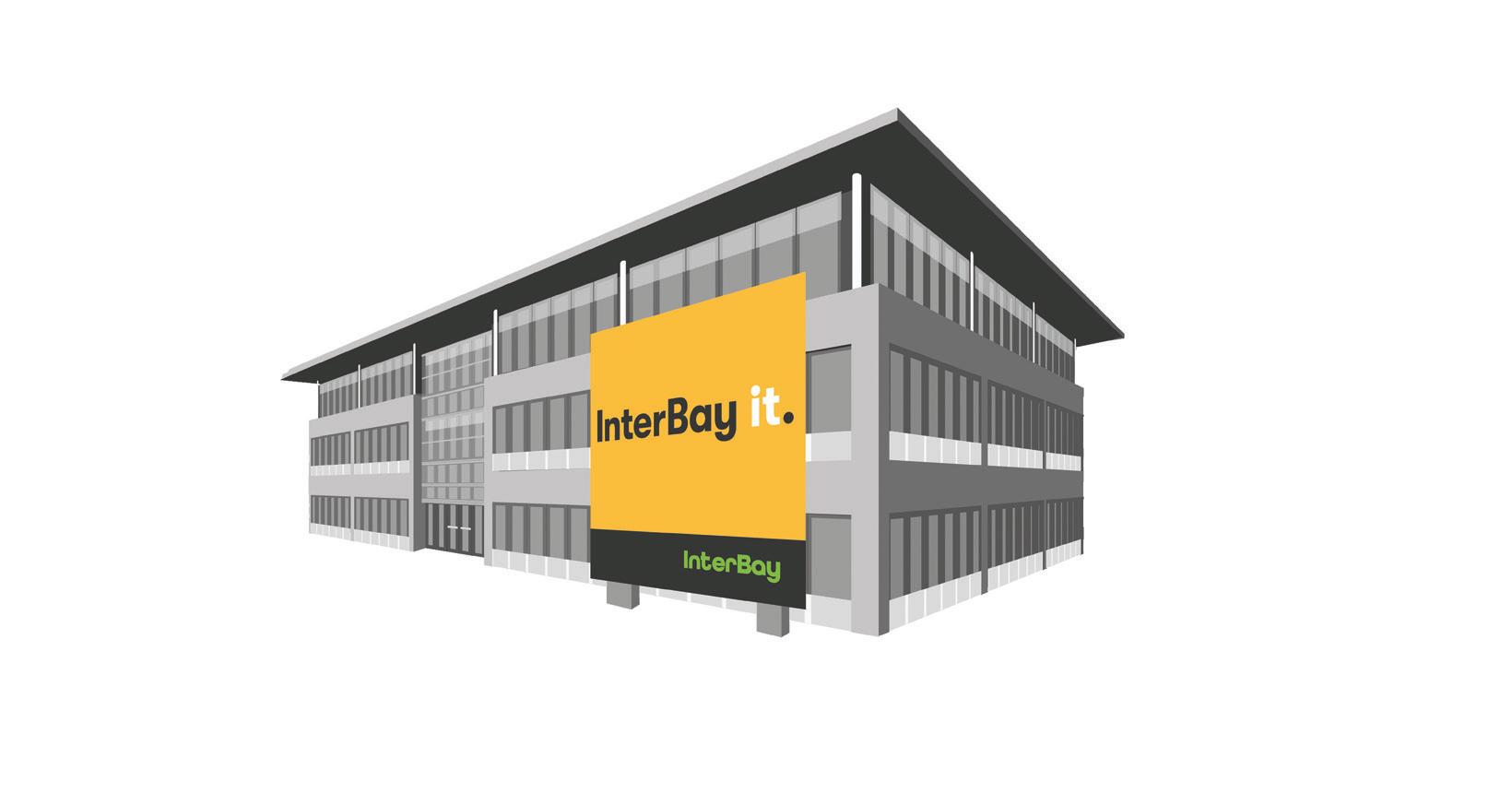
Product and criteria information correct at time of print (13.09.2024) 04-09-11 (1)
No



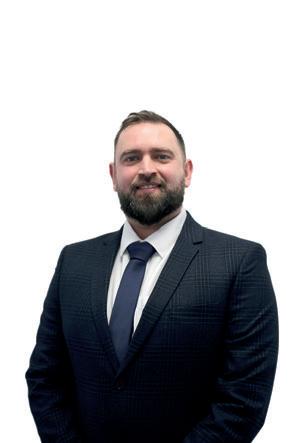


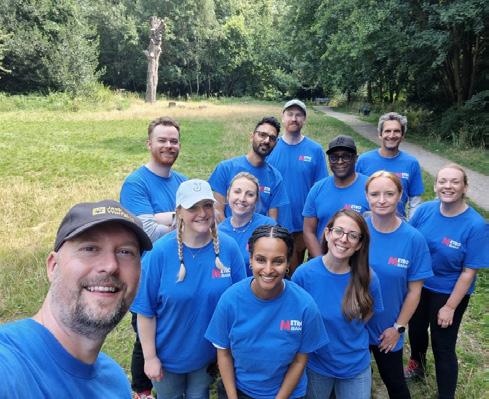






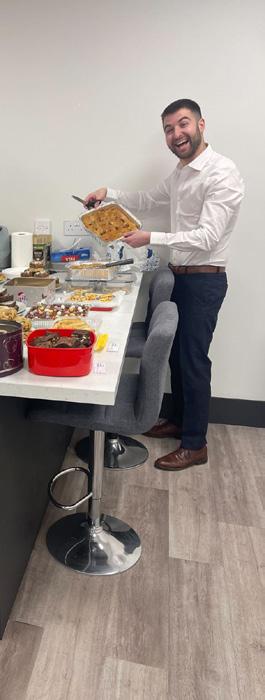

1
A glimpse into the latest charitable endeavours
Who: Tuscan Capital, powered by Allica Bank
What: Tuscan participated in the South Downs Countryside trek to raise funds for its charity partner, The Passage—an organisation dedicated to eradicating street homelessness
How: On 14th September, the team completed a 15-mile walk through the South Downs, which took them a total of seven hours. Tuscan raised over £1,500 for the charity through this initiative
2
Who: MSP Capital
What: MSP Capital organised a beach volleyball tournament to raise money for two hospice charities, Julia’s House and Lewis-Manning Hospice Care
How: The tournament welcomed 32 companies, including MSP Capital, to have fun in the sand for the good cause. Despite the rainy, grey day, six-a-side teams of women and men competed in 10-minute ‘pool’ matches on four courts, with the top scorers going into a knockout stage. In the end, MSP clinched a narrow win, and raised £20,000 for the charity
3
Who: Medianett Publishing
What: Medianett Publishing’s operations manager Lizzie Scott took part in a Race for Life this summer to raise money
for Cancer Research UK
How: On 28th July, Lizzie participated in the Race for Life 5K to support her incredible and strong parents, who have both been diagnosed with cancer. Not only did she finish the race in 30 minutes, but she also raised £550 for the charity
4
Who: Propp
What: Propp partnered once again with Wellchild, the national charity dedicated to supporting children with complex health so they can receive care at home, to complete a DIY project for Mary Rose Academy in Portsmouth How: Propp, together with dozens of people from various specialist finance firms, joined forces to create a 220 sq m sensory garden project for the academy, a special education needs school in Portsmouth. In just five days, the group finished the project from scratch, and raised almost £15,000 for the charity
5
Who: Together
What: Four teams from Together competed in a Race Across the World challenge to raise money for several charities, including Manchester Youth Zone & HideOut Youth Zone, Greater Manchester Mayor’s Charity, Forever Manchester, and Seashell Trust
How: Inspired by the popular TV show, the four teams had to plan a journey from London to Albania with a budget of £500, each using their stealth, planning and logic to find the fastest route. Together’s Sue Nicholson & Claudia Calladine claimed the first prize and, in total, the company raised over £30,000 for the charities
6
Who: Metro Bank
What: The company helped the independent charity, The Friends of Tower Hamlets Cemetery Park, to breathe new life into Cemetery Part Lodge in London How: Colleagues from Metro Bank volunteered to help preserve the cemetery’s rich history, and learned more about conservation methods
7
Who: FinSpace Group
What: The team organised a company-wide bake off to support charities, including The Soup Kitchen, which aids homeless, elderly, isolated and vulnerable individuals in London How: Together, the members baked delicious sweet and savoury treats, raising £500 for the charity
is needed to give clients the best possible deal’
In October, Christian Gugolz made waves in the industry with the announcement that he had joined Albatross Lending Group as the firm’s new head of bridging finance, following almost eight years at MT Finance. With his batteries recharged and eager to dive into his new role, Christian talks about what drove him to make this step, and his ambitions for the specialist lender
Congratulations on your new role! What attracted you to join Albatross?
Thank you! It was always going to be a difficult decision to make the move, but having met with Jordan and Lewis a few times and understanding their vision for the future and their values, together with the opportunity for a new challenge, made it a lot easier. Albatross is a fantastic firm with an already great team in place, and I am really excited to be part of it.
What will you be focusing on in your new role?
The main focus will be to build the loan book and bring in lots of business, but obviously there will be many things to do to make this happen. I will be working very closely with the team to continue their great work and ensure that everyone knows about Albatross and what we do.
What plans and lending targets does Albatross have for the next 12 months and beyond?
Without going into specific numbers, we would very much like to increase the current lending by 75-100%, which we believe is achievable. We would really like to move more into the northern broker market and continue to grow within London, the South East, and also across the South West and Wales.
What opportunities and hurdles do you foresee in the bridging market in 2024 and 2025?
My favourite question! [laughs] The bridging finance market tends to have a bit of a trend in terms of which months are quiet and which
ones are busy. However, over the past couple of years, those trends seem to have gone out the window a little. It will be interesting to see what sort of effect the change of government has on the sector moving forward. For me, the bridging sector has always been very robust and will generally perform, whether the market is strong or weak.
What is one thing the industry doesn’t know about you?
I was born in Switzerland—that’s where my surname is from! I moved over to England when I was one, and have been here ever since.
What is, in your opinion, the key quality you must have to be successful in the specialist finance industry?
I don’t think there is just one but, if I had to choose, it would be having the ability to build relationships. I know it’s a cliché, but whether you’re working as a broker, lender, solicitor, or surveyor, collaborating as a team across the board is what gets deals completed.
A few months ago, Albatross reported a 72% spike in demand for its 48-hour rescue bridge—do you expect this trend to continue in 2025?
I think we’re more likely to see a need for rescue bridging loans where clients simply just need to complete quickly. We all know that speed is of the essence in bridging, so the 48-hour rescue bridge is ideal for any type of delay.
If you could change one thing about the specialist finance sector, what would it be?
…Just one? I’m only kidding! [laughs] I don’t think I would change anything, to be honest. It’s a very competitive market with lots of good people. Competition is needed to give clients the best possible deal and there is always plenty of business to go around. Maybe I’d add more golf? [laughs]

How did you spend your very first pay cheque?
Wow, that was a long time ago! I would have been 13-14 when I first had a paper round on about £15 a week, so I most likely spent it on a CD
Your dream job—if you weren’t doing this, what would you do?
That’s an easy one—travelling the world playing golf on the PGA Tour!
What is your favourite holiday destination?
I would have to say Bali—it’s an absolutely beautiful country with incredibly kind people, a great culture and even better food! I do also happen to love a skiing holiday too and Morzine is definitely up there with one of my favourite resorts
If you had to delete all but three apps from your phone, which ones would you keep?
Spotify, WhatsApp and Sky Sports
What is the most adventurous thing you’ve ever done?
Climbing a volcano at 3am in time to see a sunrise
Live updates on every application, direct access to underwriters and live chat facilities with our experts; we’re here to make every mortgage simple, whatever your customer needs.
For intermediaries only Search LendInvest Mortgages

Unregulated lending is provided by LendInvest BTL Limited (Company No. 10845703) and LendInvest Bridge Limited (Company No. 11651573), which are wholly owned subsidiaries of LendInvest plc. LendInvest plc is a limited company registered in England No. 08146929. Registered office at: 8 Mortimer Street, London, W1T 3JJ. Borrowing through LendInvest and its affiliates involves entering into a mortgage contract secured against property. Your property may be repossessed if you do not repay your mortgage in full.